Click on images or links for larger versions of the images.
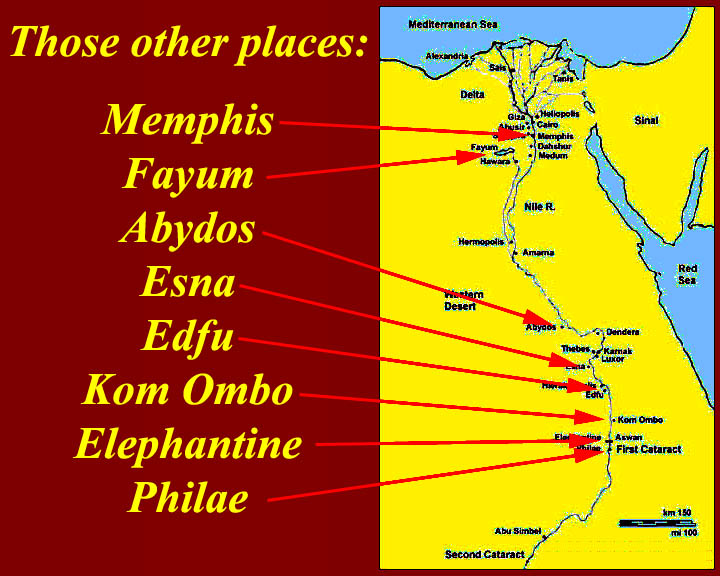
http://www.mmdtkw.org/EGtkw0801EgyptMap.jpg
Further information will be given on the sites listed.
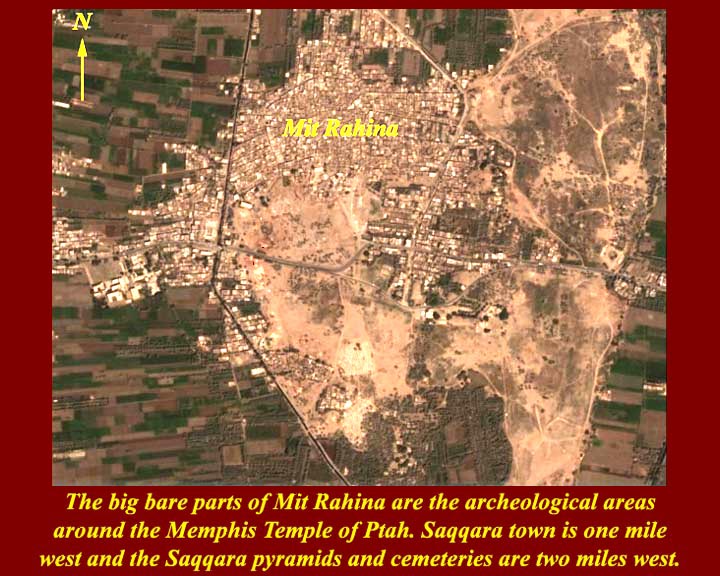
http://www.mmdtkw.org/EGtkw0802MemphisMitRahina.jpg
The modern Egyptian town of Mit Rahina ("Hundred Hostages") is at the edge of the Memphis temple complex of Ptah. The extent of Memphis is unknown, but it was always either the first or second city of Ancient Egypt, i.e., much bigger than Mit Rahina.
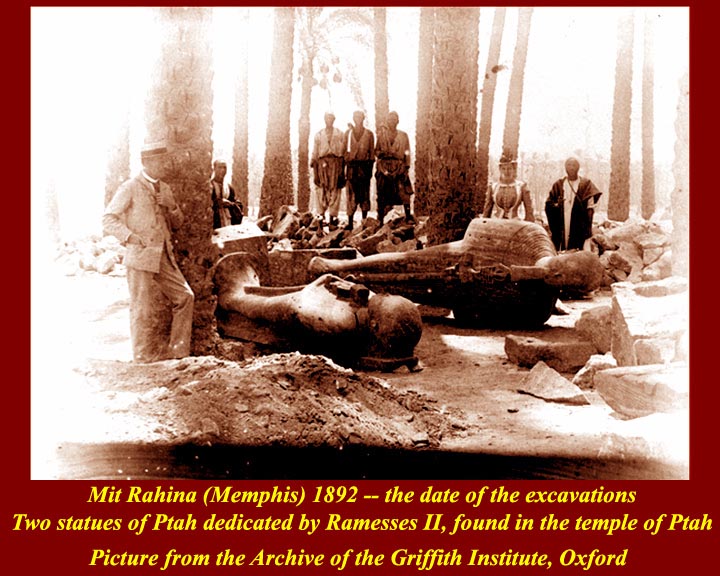
http://www.mmdtkw.org/EGtkw0803MitRahina1892.jpg
The Ptah temple complex has been under more or less constant excavation since the early 1890s.
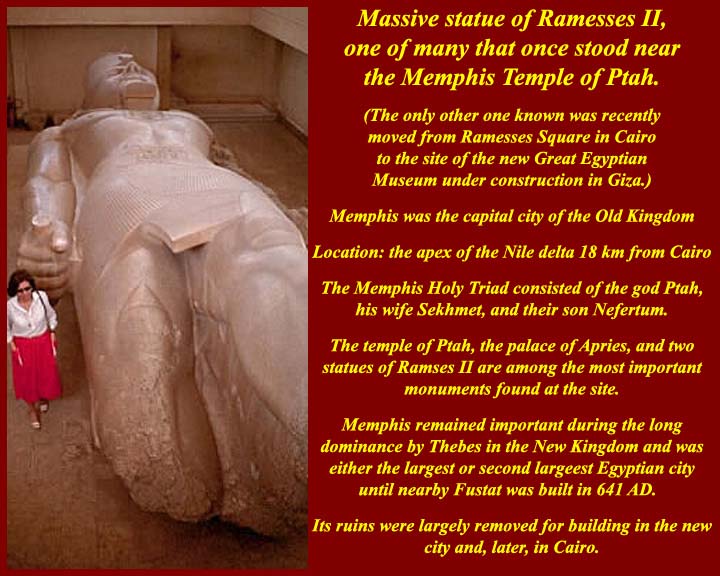
http://www.mmdtkw.org/EGtkw0805aRamessesII.jpg
As he did elsewhere, Ramesses II set up massive statues of himself in the temple complex. Only two survive, this one on its back in a small modern building at the site, and another of equal size that was recently moved from Ramesses Square, Cairo, to the site of the Great Egyptian Museum, which is under construction just north of the Giza pyramids (see below).
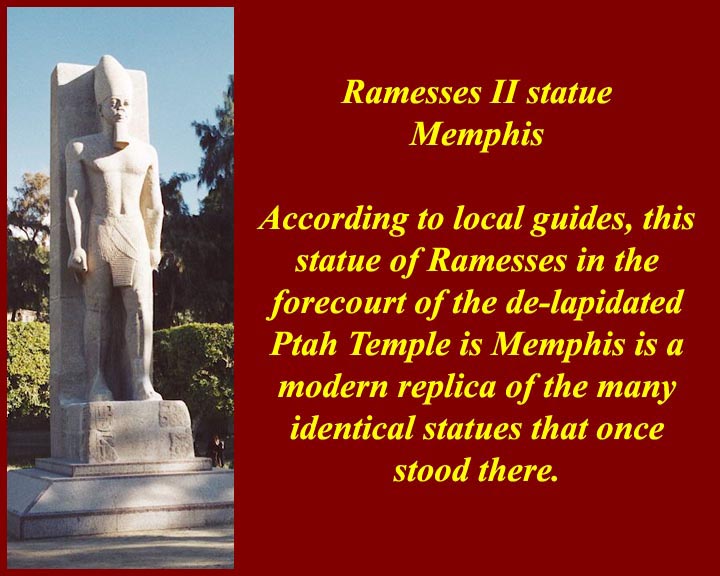
http://www.mmdtkw.org/EGtkw0805bRamessesII.jpg
The pictured Ramesses statue at Mit Rahina is a modern copy.
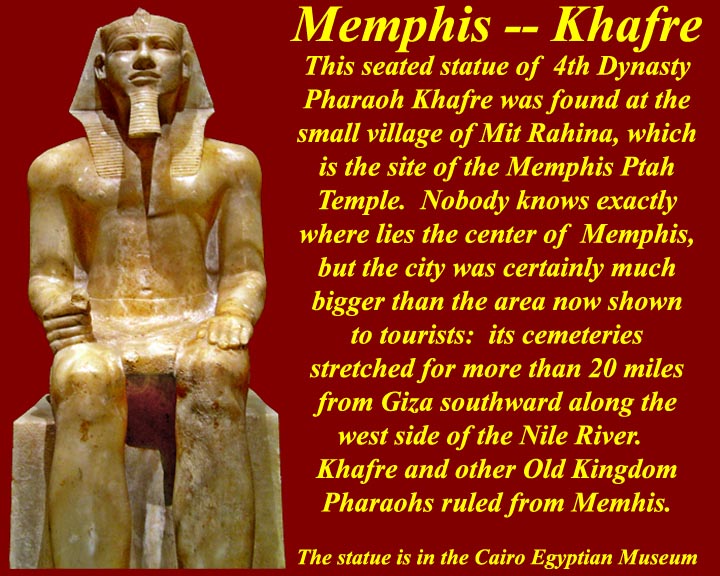
http://www.mmdtkw.org/EGtkw0806Khafre.jpg
This exquisite Old Kingdom statue of Pharaoh Khafre, whose pyramid at Giza is second only to that of his father, Khufu, was recovered at Mit Rahina and is now in the Cairo Egyptian Museum.
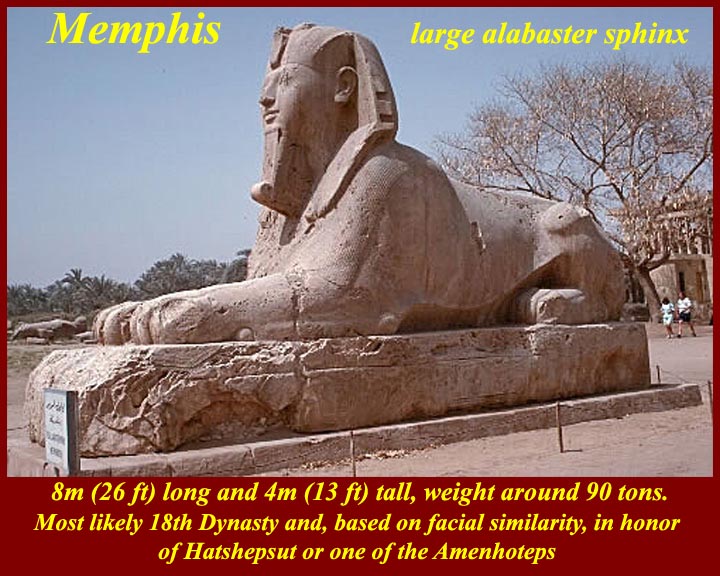
http://www.mmdtkw.org/EGtkw0807AlabasterSphinx.jpg
The Memphis alabaster sphinx is 26 feet long and 13 feet tall. The face may be Hatshepsut or one of the Amenhoteps.
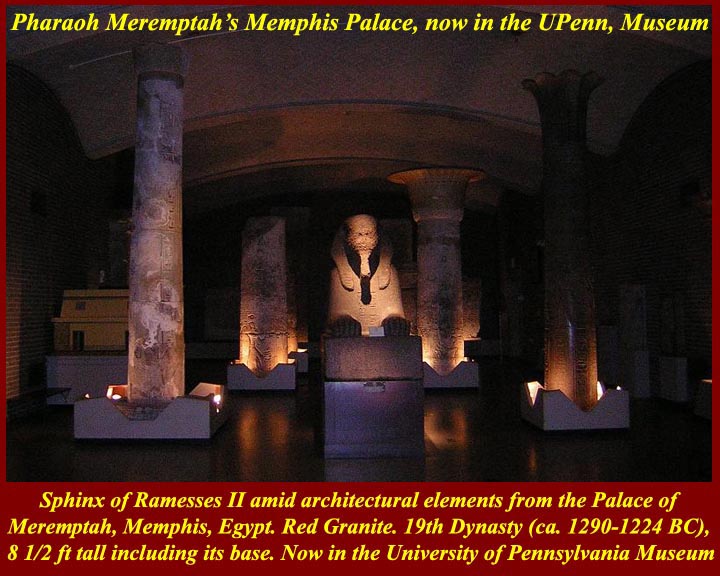
http://www.mmdtkw.org/EGtkw0808PennSphinx.jpg
Another Memphis Sphinx now sits in the University of Pennsylvania Museum of Archeology and Anthropology amid columns from the Palace of Meremptah, also from Memphis. Among the University's distinguished graduates is Zahi Hawass, who received his Ph.D. from UPenn. The Museum has permanent Egyptian exhibits and is now celebrating the "Year of Egypt". For information, see http://www.museum.upenn.edu/index.php
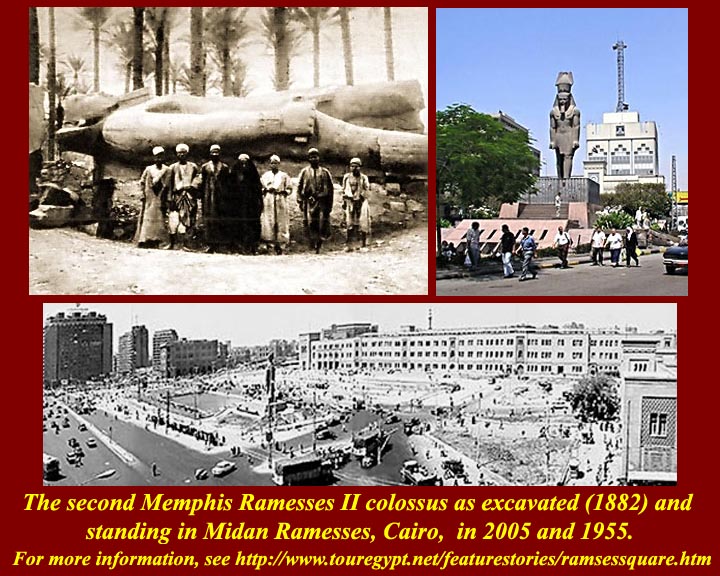
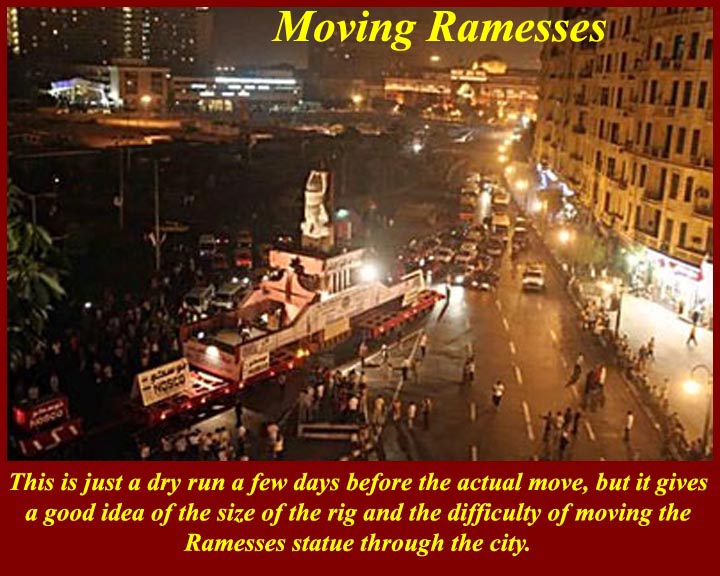
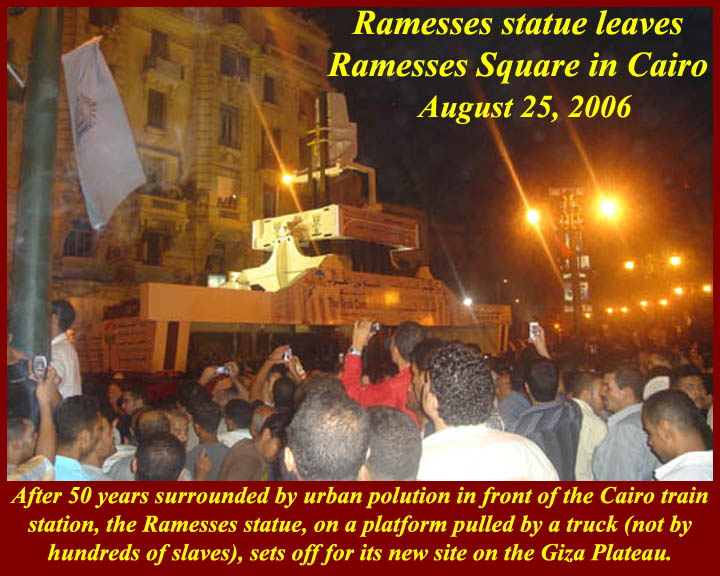
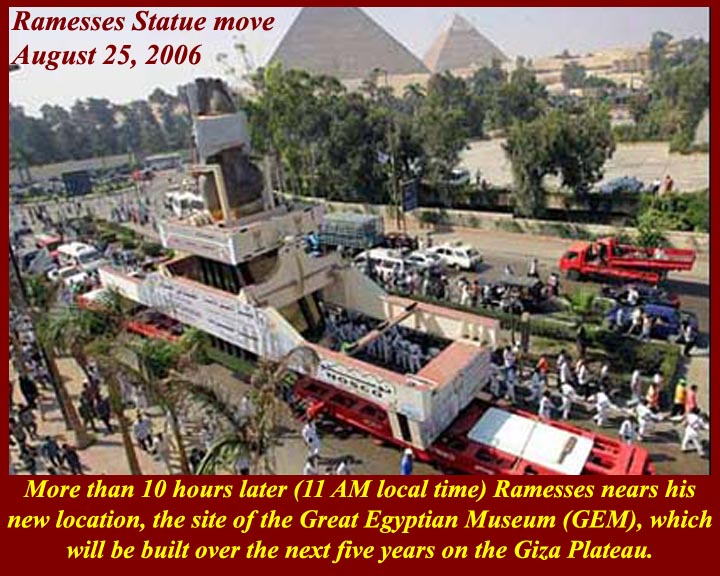
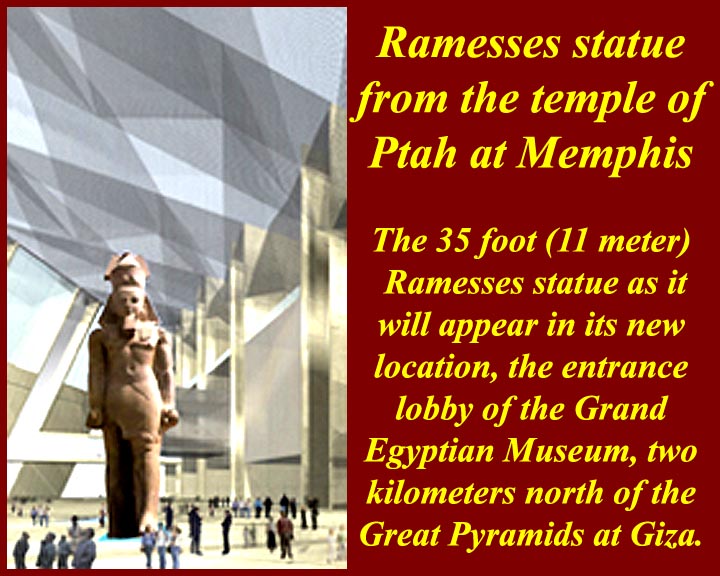
http://www.mmdtkw.org/EGtkw0809RamessesSquare.jpg
http://www.mmdtkw.org/EGtkw0810RamessesStatueMove1.jpg
http://www.mmdtkw.org/EGtkw0811RamessesStatueMove2.jpg
http://www.mmdtkw.org/EGtkw0812RamessesStatueMove3.jpg
http://www.mmdtkw.org/EGtkw0812RamessesStatueMove4.jpg
An 11 meter statue of Ramesses II found at Mit Rahina (Memphis) stood in front of the Cairo railway station for 50 years before it was moved to the site of the new Grand Egyptian Museum in Giza. The new museum will not replace the Cairo Egyptian Museum, but rather it will allow for the display of much that has been in storage for lack of display space. The collection will be shared between the two museums.
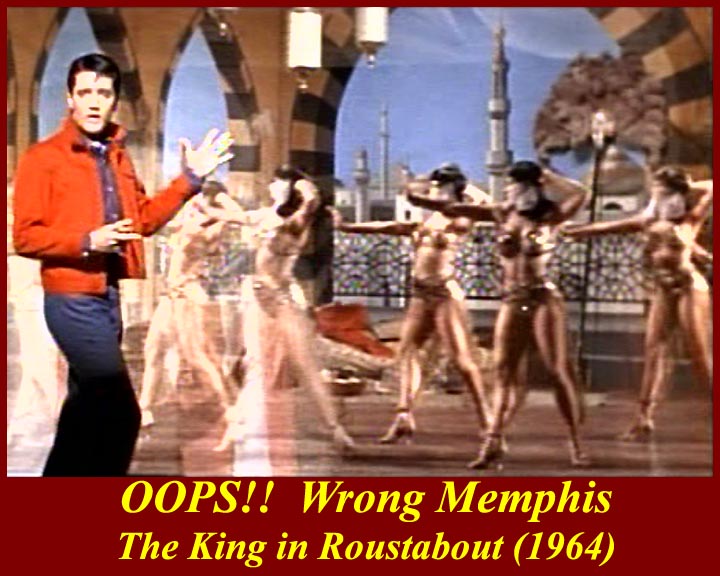
http://www.mmdtkw.org/EGtkw0813WrongMemphis.jpg
A one pharaoh dynasty.
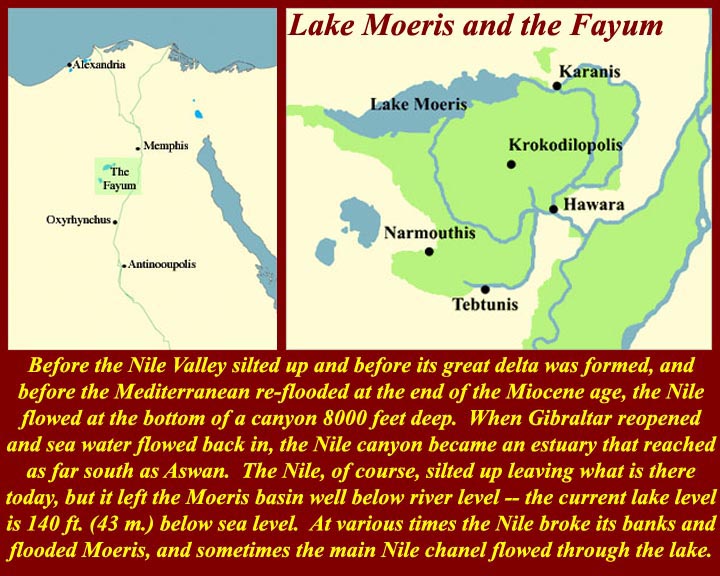
http://www.mmdtkw.org/EGtkw0814FayumMoeris.jpg
Fayoum is one of several natural depressions west of the Nile River, but it's the only one close enough to have once been part of the river's course. In pharaonic times canals were dug to enhance the flow of inundation water into Lake Moeris, and this confused both ancient and modern observers who thought that the connection of the lake and the river was fully man-made.
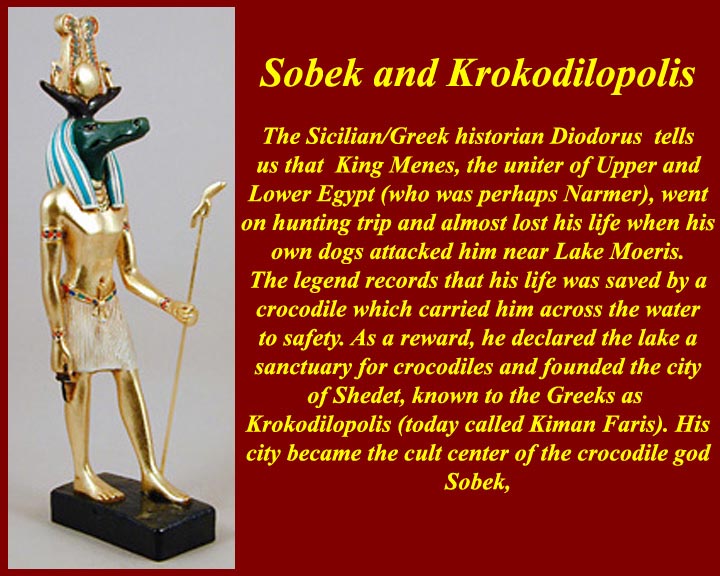
http://www.mmdtkw.org/EGtkw0815KrokodilopolisSobek.jpg
Legend has it that Pharaoh Menes was saved from an attack by his own hunting dogs by a passing crocodile who carried the pharaoh across Lake Moeris on his back. The pharaoh, in gratitude, declared the lake a crocodile sanctuary and founded the city of Shedet on the spot -- later the Ptolemies called the place Crokodilopolis. The city that Menes founded was the location of one of the cults of Sobek, the crocodile god.
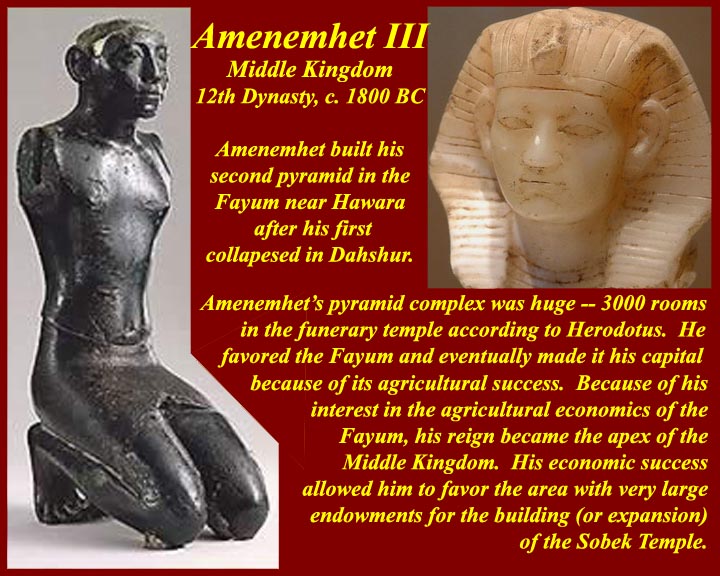
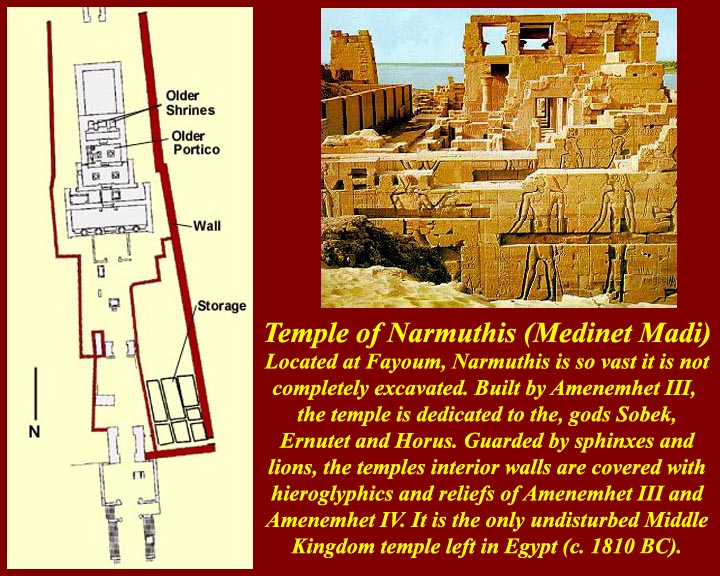
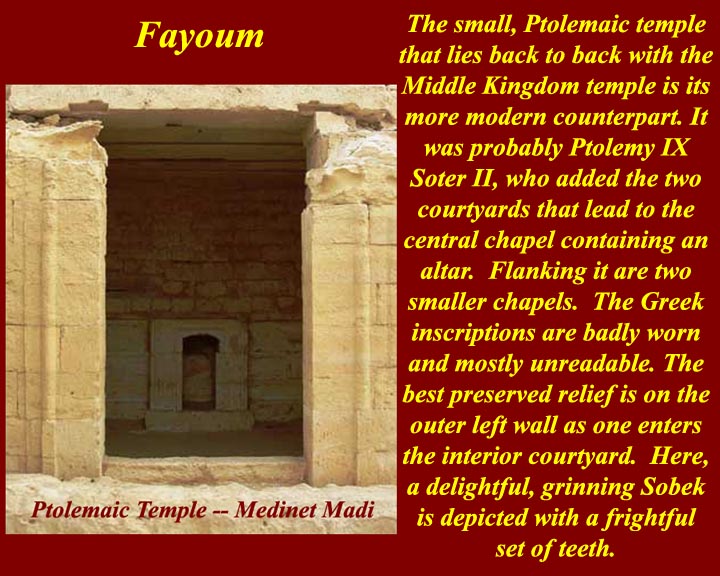
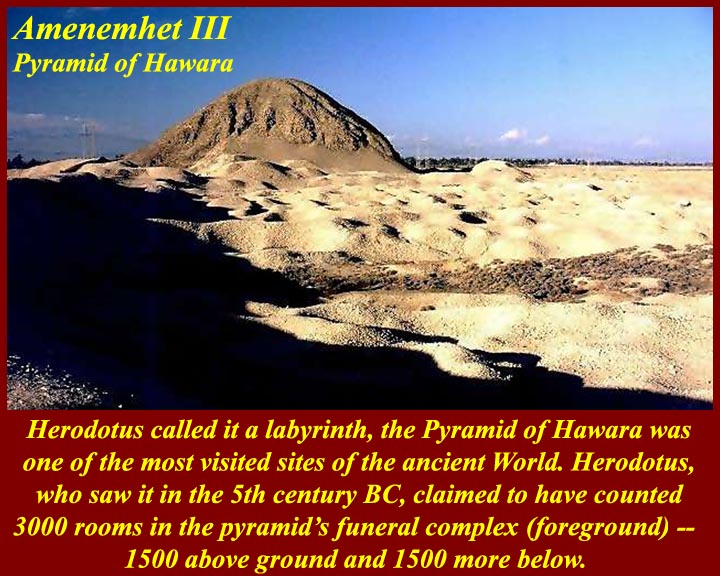
http://www.mmdtkw.org/EGtkw0816Amunemhet.jpg
http://www.mmdtkw.org/EGtkw0817NarmuthisTemple.jpg
http://www.mmdtkw.org/EGtkw0818PtolemaicMedinetMadi.jpg
http://www.mmdtkw.org/EGtkw0819HawaralPyramid.jpg
Amunemhet III built his second pyramid at Hawara in the Fayoum after his first effort collapsed at Dahshur. He took a great interest in the Fayoum as an agricultural area and eventually moved his capital there. The agricultural wealth of the Fayoum made his reign one of the most sucessful of the Middle Kingdom. The temple that he built (to Sobek, of course) at Narmuthis (now Medinet Madi) is very large and has never been completely excavated. It is the only known Middle Kingdom temple that was neither despoiled not re-built. The Ptolemies did build a temple to Sobek at Medinet Madi, but the built it adjoining the Middle Kingdom temple rather than replacing or expanding it. Amunemhet's pyramid is now just a huge pile, and in front of it is a huge hummocky field which is thought to be the remains of the "labyrinth" that Herodotus described: the "3000 rooms on two levels" that was probably Amunemhet's large pyramid temple.
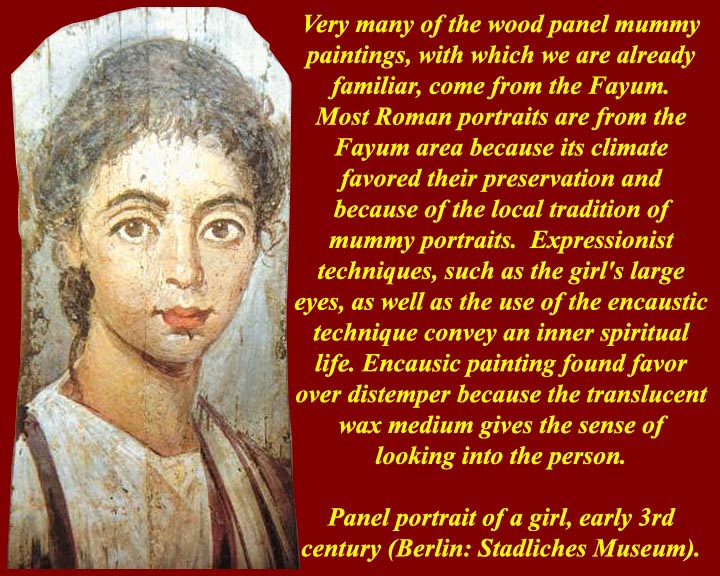
http://www.mmdtkw.org/EGtkw0820MummyPainting.jpg
The Fayoum is also the source of very many of the "mummy paintings", often encaustic on wood, with the famous large "look right at you" eyes. Some say that the paintings were the origin of a Roman portraiture tradition and even that the mummy paintings were painted from life and displayed in houses before death. Whether painted from life or after death, they were cut to fit and then wrapped into the outer layer of Ptolemaic and Roman period mummy wrappings over the face of the deceased. The paintings look very alive and each is unique leading to the belief that they are actual portraits (but perhaps with exaggerated eyes). This one has the pursed lips of the Ptolemaic style, but it's impossible to tell whether this was an artistic convention or a personal or an ethnic facial characteristic. Encaustic painting involves mixing pure pigment or oil based paint with hot wax (usually beeswax). The mixture was/is applied hot and gives remarkable depth. It was preferred over distemper painting in which a small amount of animal glue was mixed with chalk and pigment. Distemper was used in later times for temporary work -- banners, signs, and stage sets (where it is still used).
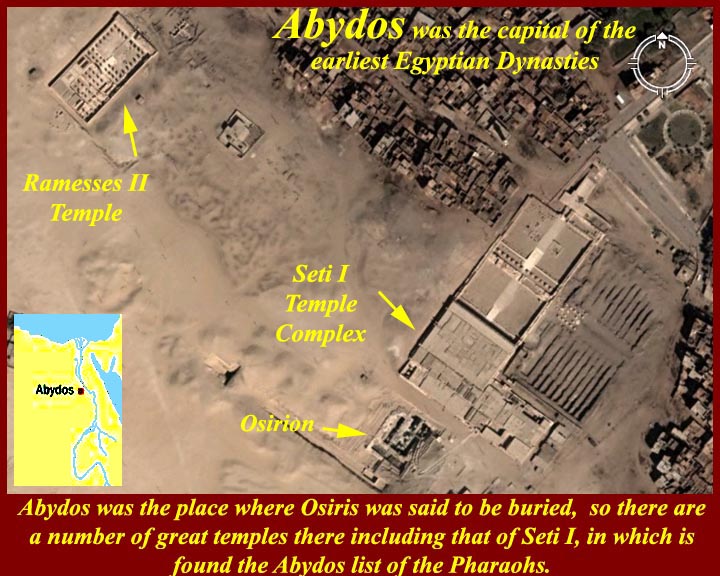
http://www.mmdtkw.org/EGtkw0822AbydosSatellite.jpg
Abydos was the capital of first dynasties of the Old Kingdom. It was sacred to Osiris, who was thought to have been reanimated here before his intercourse with Isis that produced Horus. (But that was also said to have happened elsewhere.) After being temporarily reanimated Osiris was said to have been chopped up by his enemy/brother Set and the reassembled and burried in Abydos. There is also a legendary connection between Osiris and mummy wrapping: it was believed that the wrappings were first applied to Osiris to hold together his various parts that Isis had collected. There is some diagreement about the order of all these events. Some legends say that he had to be reassembled before the sex, but that's illogical since his penis is the one part that never was found, according to legend -- illogical, but it is a myth after all.
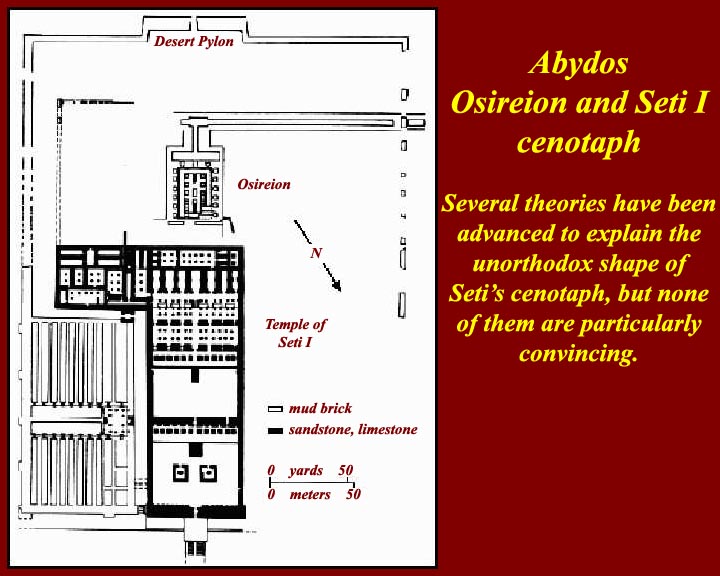
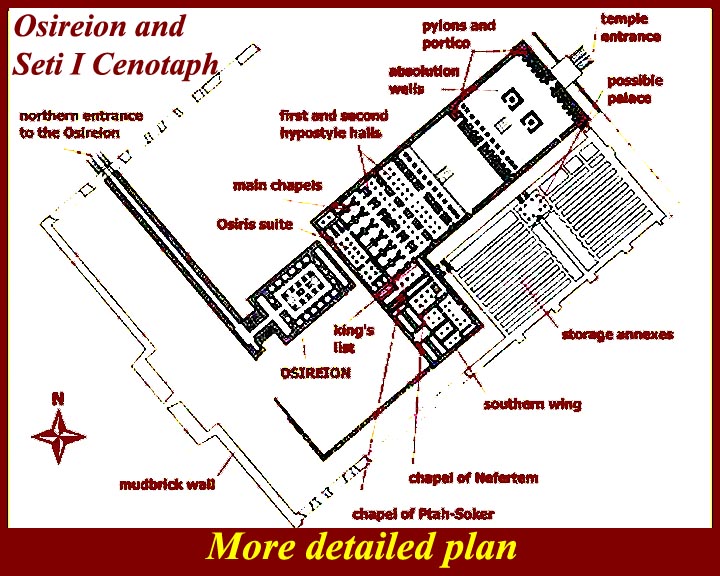
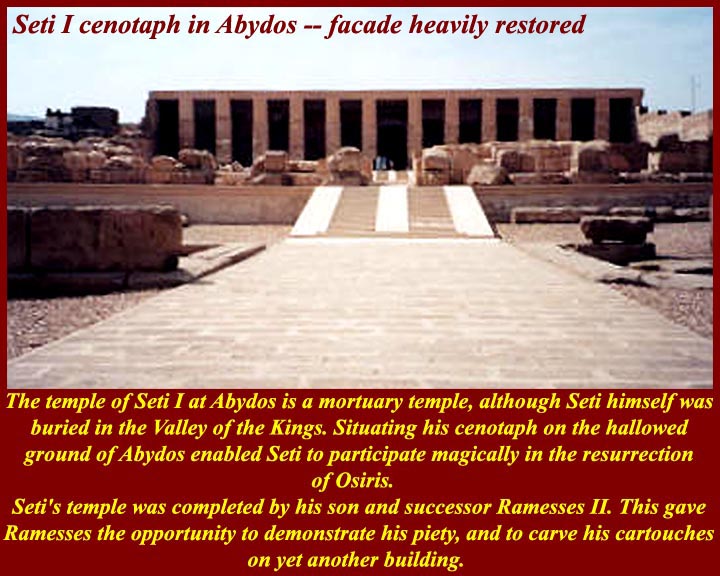
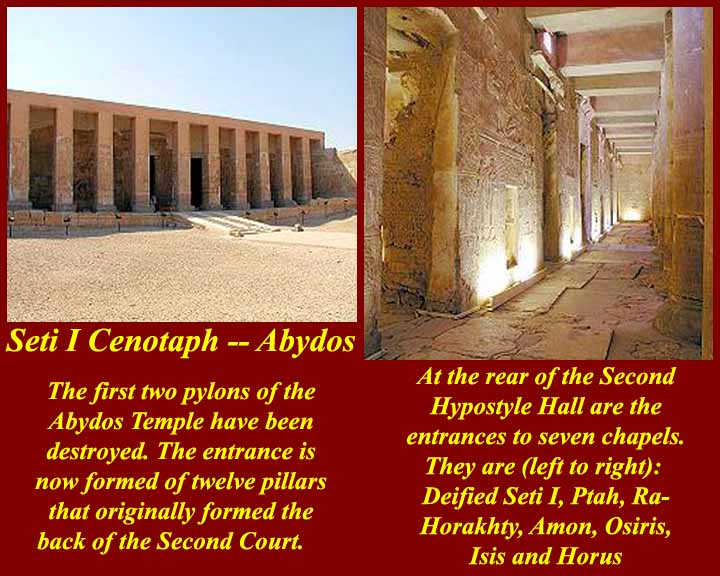
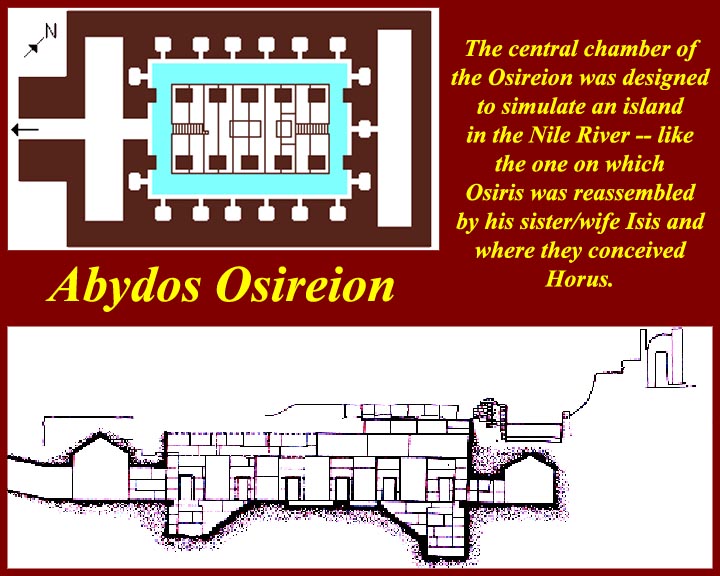
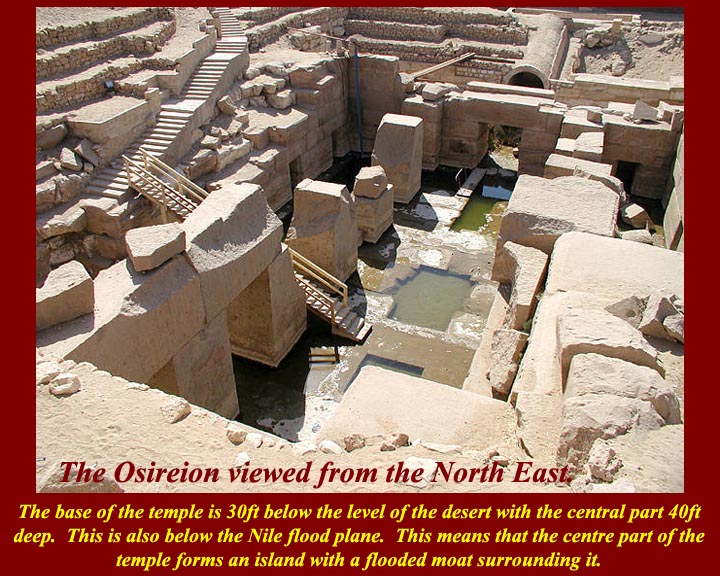
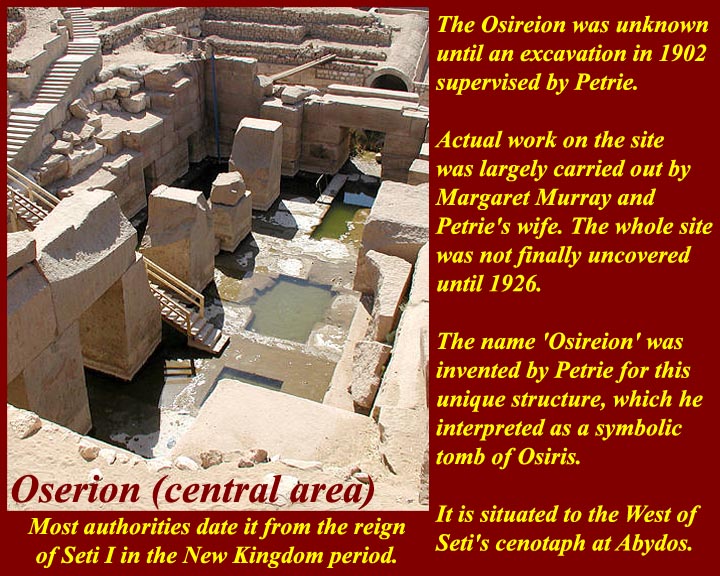
http://www.mmdtkw.org/EGtkw0823SetiI-Osireion1.jpg
http://www.mmdtkw.org/EGtkw0824SetiI-Osireion2.jpg
http://www.mmdtkw.org/EGtkw0825Seti1Abydos.jpg
http://www.mmdtkw.org/EGtkw0828SetiI-Osireion3.jpg
http://www.mmdtkw.org/EGtkw0828AbydosOsireion.jpg
http://www.mmdtkw.org/EGtkw0830Osireion_01.jpg
http://www.mmdtkw.org/EGtkw0831Osireion_02.jpg
Seti I built his cenotaph (equivalent to a "Valley Temple" but far from his tomb) directly in front of what was by his time a long established shrine to Osiris (called the Osireion by the Ptolemies and so until today). The shape of Seti's structure in unorthodox, and several unproven theories have been advanced for the anomaly, the most convincing one being that something discovered during construction was thought to be important enough for inclusion. The Osireion is thought to have been a water shrine built below ground level so that ground water would surround a central area which would then represent the mound on which the slain -- but not yet dismembered -- Osiris washed up out of the Nile. (Grammar query: can three consecutive prepositions possibly be correct?) Ramesses II, the son and successor of Seti I, finished his father's temple and then built a smaller temple nearby. A gesture of filial piety? It was one of the few times he didn't try to tower over whatever was there first at a site first used by an earlier builder
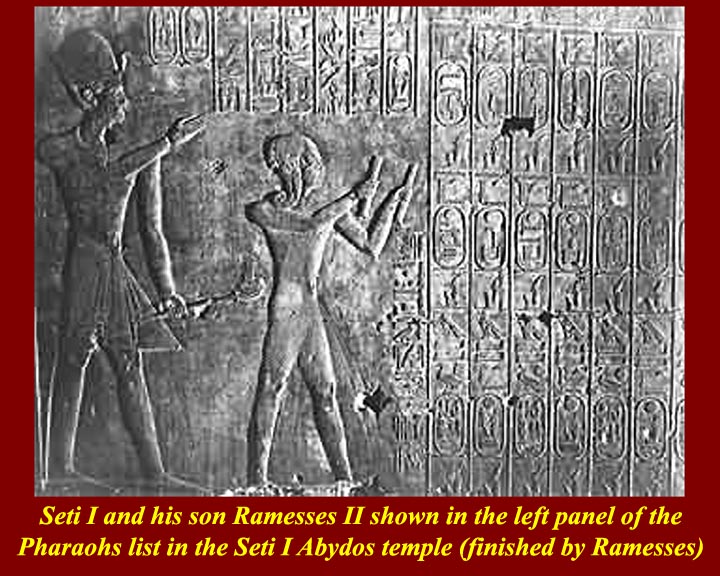
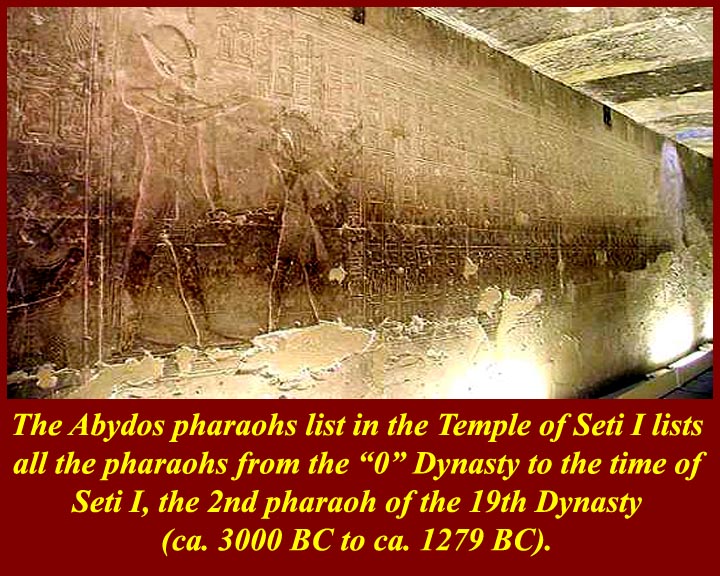
http://www.mmdtkw.org/EGtkw0832Seti1AbydosKingList.jpg
http://www.mmdtkw.org/EGtkw0833AbydosKingList.jpg
The list of pharaohs in the Seti I cenotaph is extremely important to the twelve or so people in the world who really feel the need to know exactly which pharaohs preceeded and which came after other pharaohs. But there is some political correctness involved in the list. Some of the self-proclaimed Lower Egyptian pharaohs of the second intermediate period didn't get a mention -- only the Upper Egyptian guys counted. Seti was, of course, an upper Egyptian. Luckily, those twelve people, who just must know, also have other sources of information.
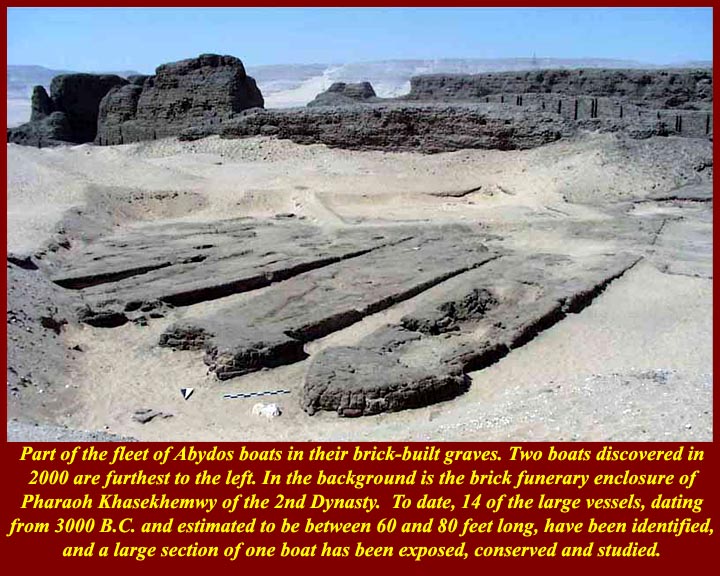
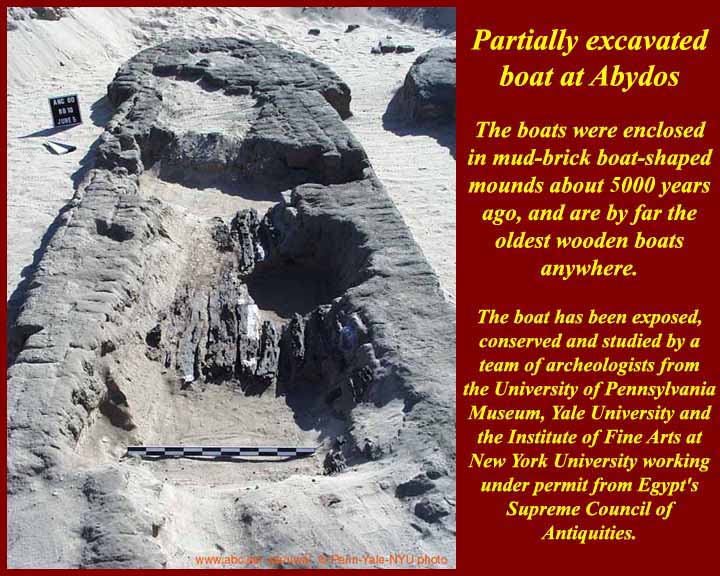
http://www.mmdtkw.org/EGtkw0834AbydosBoatGraves1.jpg
http://www.mmdtkw.org/EGtkw0835AbydosBoatGraves1.jpg
A fleet of at least 14 large boats, about 25 meters long, a few meters wide, and one meter deep are entombed in mud brick eight miles from the the west side of the Nile in the desert behind Abydos near the burial complex of the late 2nd Dynasty pharaoh Khasekhemwy. Excavations in 2000 revealed that the boats were river-worthy (not just models), that they might have held as many as 24 rowers, and that they were considerably older than Khaskhemwy's reign, perhaps as old as the reign of the semi-mythical Aha, the second -- or first, or both -- pharaoh of the First Dynasty. Like the two boats found at the Pyramid at Giza, the single boat that was actually partially excavated in 2000 was held together by mortised ropes. There was no internal stucture (i.e., no ribs). These are the earliest known built boats (as opposed to dugouts or bound reeds) but their complexity leads to the belief that earlier and simpler boats would also have existed and that they are perhaps awaiting discovery. Much more detail is at http://www.geocities.com/TimesSquare/Alley/4482/Abydosboat.html and at http://www.archaeology.org/online/news/abydos.html.
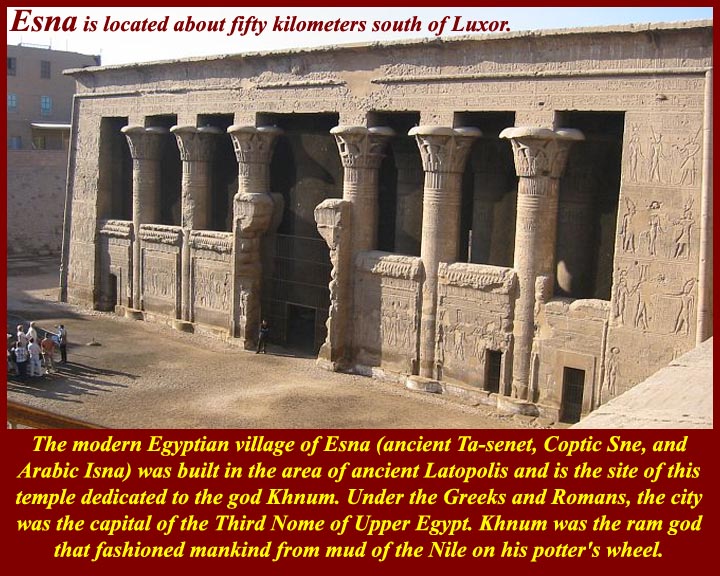
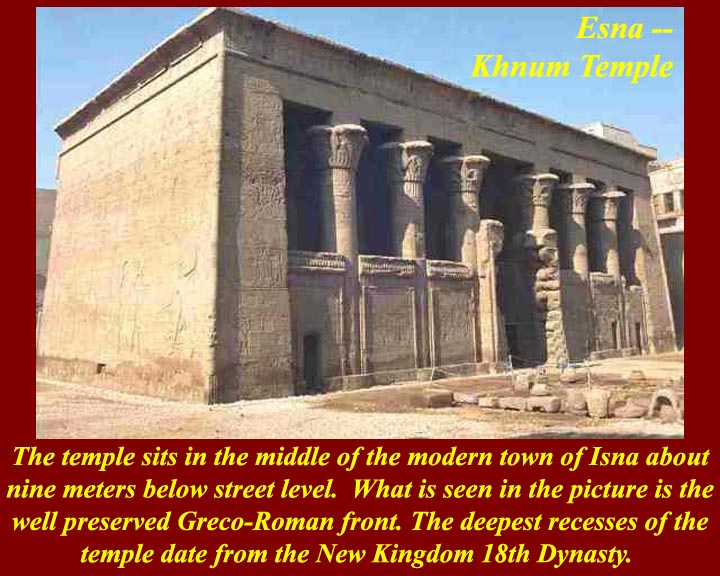
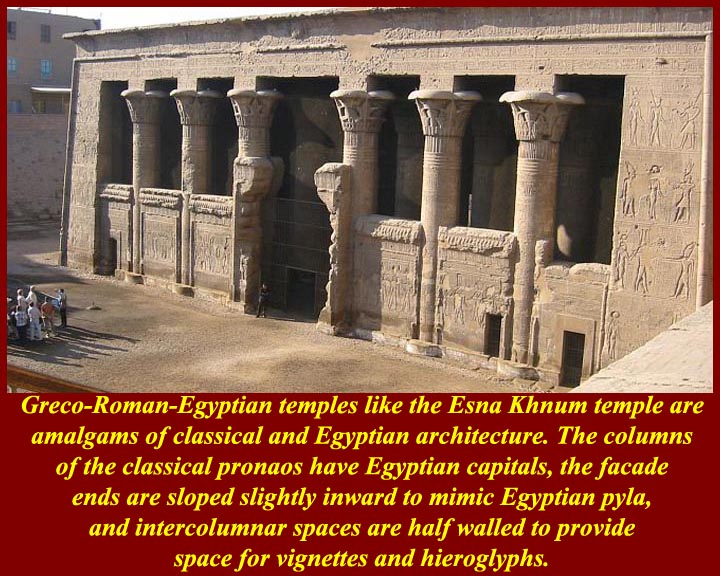
http://www.mmdtkw.org/EGtkw0836KhnumTempleEsna.jpg
http://www.mmdtkw.org/EGtkw0837KhnumEsna.jpg
http://www.mmdtkw.org/EGtkw0838KhnumArchitecture.jpg
New facades were sometimes added to older temples by the Ptolemies and the Romans. Sometimes an entirely new shell would be constructed to surround a smaller and older temple. Greco-Roman temple facades were a mixture of classical and Egyptian architecture. A classical pronaos (it means "in front of the naos or holy place) would be built, but the pillars and their capitals would be Egyptian. Intercolumnar spaces were half walled: it allowed more space for Egyptian vignettes and hieroglyic inscriptions. Behind the pronaos might be a courtyard or a hypostyle hall and a standard Egyptian temple. The Temple at Esna (in the middle of the modern Arab town of Isna) was dedicated to Khnum, a ram or ram-headed god who supposedly created and animated men and animals. In some versions of the myth he made prototypes on his potter's wheel who then reproduced themselves. In other versions, a special creation occurred for each individual: a miniature human or animal would be spun on Khnum's pottery wheel and then inserted in the womb (sometimes with the aid of a human sexual act).
For a short article on Khnum, see http://www.touregypt.net/featurestories/khnum.htm.
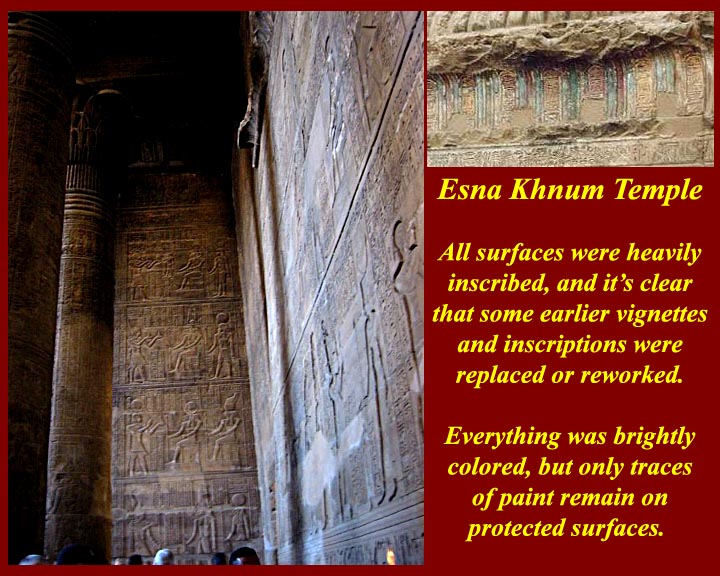
http://www.mmdtkw.org/EGtkw0839KhnumEsnaInscribed.jpg
Surfaces in Egyptian temples were always covered with vignettes (pictures) and hieroglyphs (writing). Later pharaohs and officials had to either rework older example or expinge them to get their own names and imafes up on the walls and pillars.
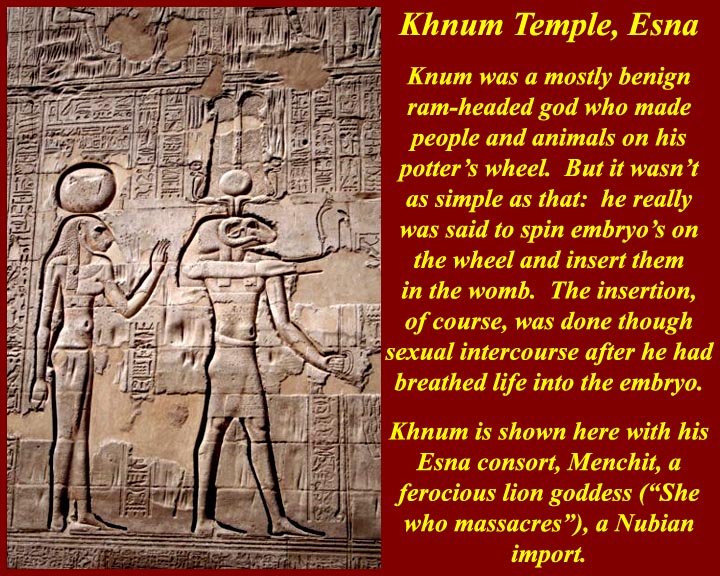
http://www.mmdtkw.org/EGtkw0840KhnumMenchit.jpg
In Esna, Khnum's consort was the ferocious lioness goddess Menchit. But at Elephantine Island, where Khnum was also worshipped, his consort was the benign Heket, a frog goddess. How did he get away with that? The simple answer is politics (with perhaps an admixture of economics.) Egyptian towns formed alliances and federations and local gods and goddesses of thos towns, naturally, got together. Bigger alliances produced larger groupings: the Heliopolitan Ogdoad had eight members, four gods and four goddesses who together made up the elements of the Middle Kingdom creation myth. The more common grouping was a triad: there were dozens of them including the ones at Esna and Elephantine, in which Khnum participated. They all followed a similar pattern: girl meets boy (alliance), a child results (fusion of the two local beliefs), the three rule until overtaken by events (either expansion into a greater federation, or the treaty breaks down, or sombody bigger overwhelms your triad.
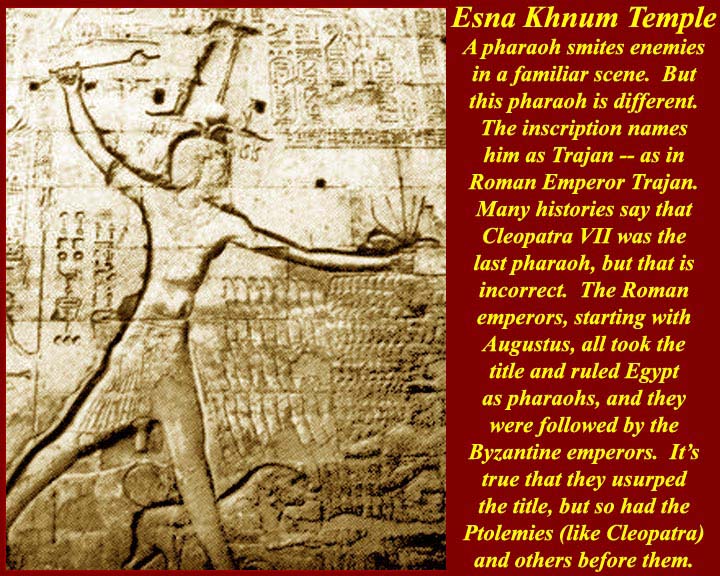
http://www.mmdtkw.org/EGtkw0841KhnumEsnaTrajan.jpg
Or somebody bigger overwhelms your country. The arrival of Rome marked a very big change for Egypt. Previous conquerors like the Hyksos, Libyans, Nubians, and Greeks (Ptolemies) moved in and ruled from somewhere in Egypt. It's true that for two short periods the Persians ruled from outside, but the Romans did so long term. When a Roman vignette appears on a temple wall, like this one of Trajan at the Esna Khnum temple, the enemies that Pharaoh Trajan smites are likely to be conquered Egyptians rather than foreign enemies. We need to remember that for internal political reasons, the Romans (Octavian Caesar, later Augustus, and the Senate) declared war on Cleopatra and not on Mark Antony. As one of his first acts after defeating Cleopatra -- and, of course, Antony -- Octavian had himself declared Pharaoh in Alexandria.
And, by the way: the suicide of Cleopatra VII left her son by Julius Caesar, whose name was Ptolemy Caesar, as sole pharaoh: both Cleo and Ptolemy Caesar had the title of pharaoh even though he was just a child. Octavian Caesar had Ptolemy Caesar killed, reportedly saying there could only be one Caesar. So the pharaonic succession went from Cleo VII to Ptolemy Caesar to Octavian Caesar and therafter to succeeding Roman and Byzantine emperors. That meant that Egypt was always a personal fiefdom of the emperors and that any Roman governor who embezzled was also guilty of lèse-majesté. (Etymology: laesae, feminine genitive of laesus, past participle of [latin] laedere, to injure + m
 iest
iest tis,
genitive of m
tis,
genitive of m iest
iest s,
majesty.)
s,
majesty.)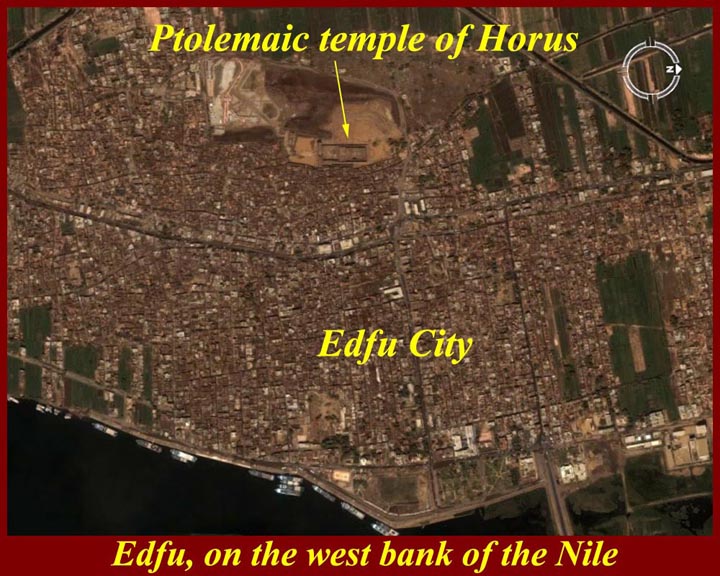
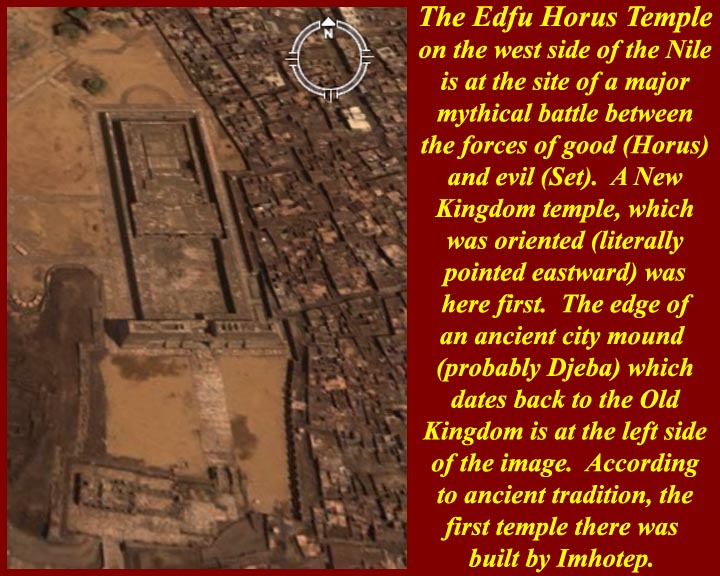
http://www.mmdtkw.org/EGtkw0842EdfuSatellite1.jpg
http://www.mmdtkw.org/EGtkw0843EdfuSatellite2.jpg
Edfu had a traditional connection with Horus and was part of one of the triad god alliances: Osiris and his sister/wife, Aset/Isis produced Horus, who was also a reincarnation of the dead Osiris and the pharaoh, in turn was the physical embodiment of Horus. From very early days, Edfu was a Horus cult center.
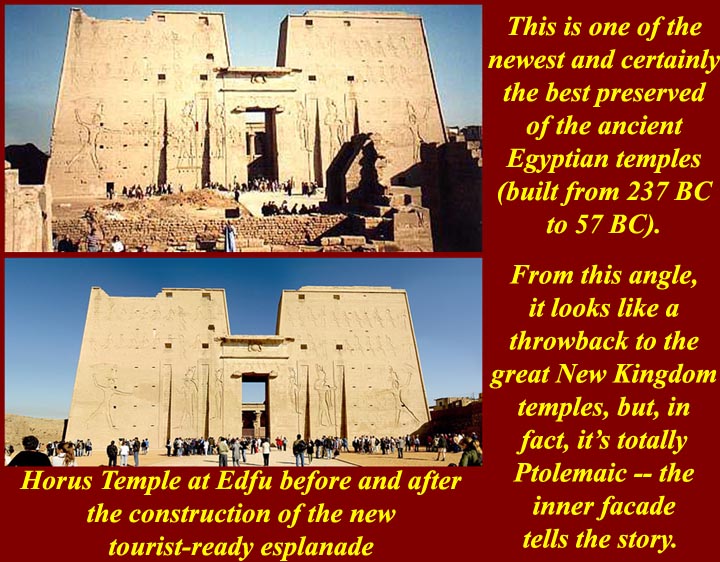
http://www.mmdtkw.org/EGtkw0844EdfuHorus.jpg
Despite the age of the cult center, the major elements of the Horus temple are among the most recently constructed. It appears to have been the last major temple built by the Ptolemies, and therefore the last major temple built in Egypt. It is certainly the best preserved Egyptian Temple. From in front of the first pylon, it looks like the standard Egyptian temple complex.
http://www.mmdtkw.org/EGtkw0845EdfuInnerFacade.JPG
The inner facade, however, is clearly Greco-Roman-Egyptian. At the left side of the temple door stands a huge Horus bird and part of one is on the ground at the other side of the door.
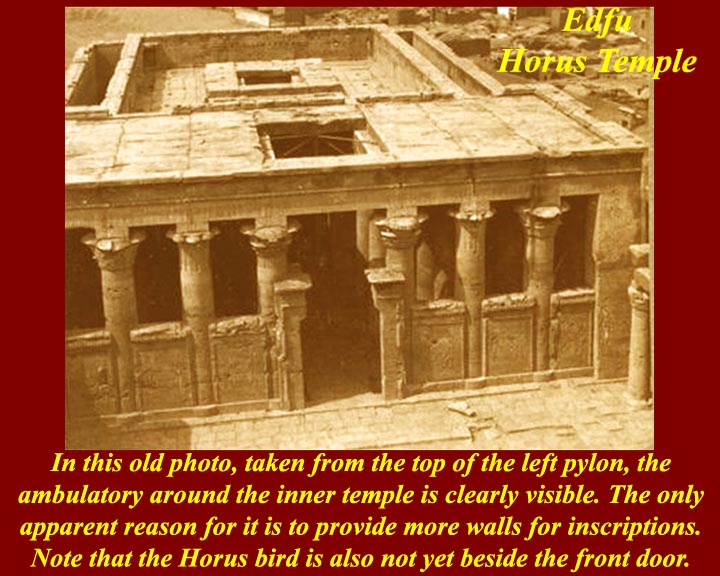
http://www.mmdtkw.org/EGtkw0846EdfuFromAbove.jpg
An older photo taken from the top of the left pylon shows the passagewy surrounding the inner temple. The Horus birds are nowhere to be seen.

http://www.mmdtkw.org/EGtkw0847SolarBoatEdfu.jpg
Gods and goddesses visited each other and they got to each other's
houses in Solar Boats. Early on, these may have been real boats that carried cult images on the river and on canals, but in later periods they were man carried models like the one in the image and were never intended to be put in the water. In fact there were other boats -- barges -- that carried one or more the ceremonial models and their bearers. The models carried visiting cult images to rooms adjoining the inner sanctums of the god-owners of the temples. This "solar barque" was made to carry a cult image of Hathor to the abode of he husband Horus. The name of Hathor was really Het Hora and was written as Het Horet or as Het Hert, the last "t" being an unpronounced feminine determinative hieroglyph -- one of the hieroglyphs that in other uses signified a "t" sound, but not here. It's generally accepted that Hathor's name is derived from "Het" meaning "house" and "Horu", that is, Horus. Het Horet was the (feminine) House of Horus, either the Sky where the Horus bird flew, or, more allegorically, her location, wherever it might be, was where he felt "at home". Some interpreters add a sexual significance to her name, i.e., his home (Het Horet) was where he went for intercourse. Whenever gods and goddesses who were consorts visited each other they were, in fact, given some private time for a conjugal visit in a part of the temple complex -- usually a separate dedicated chamber or building -- which was called a mamisi by the Ptolemies and the Romans. For much more information about Het Horet, see http://www.hethert.org/.
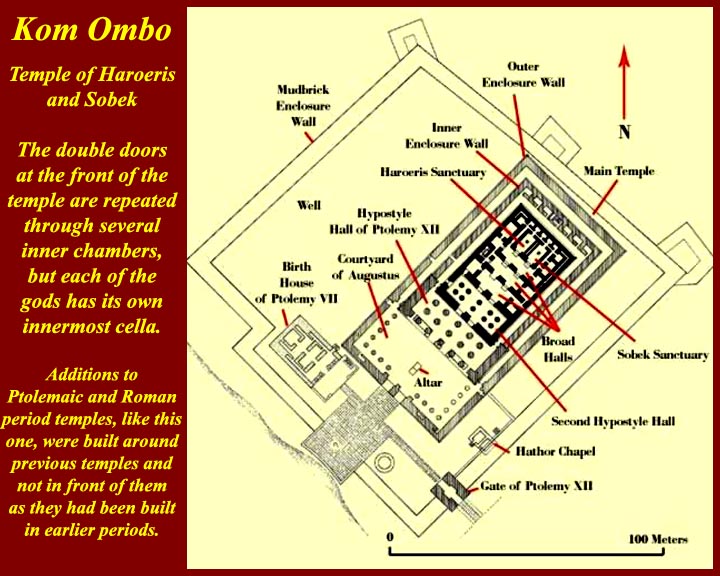
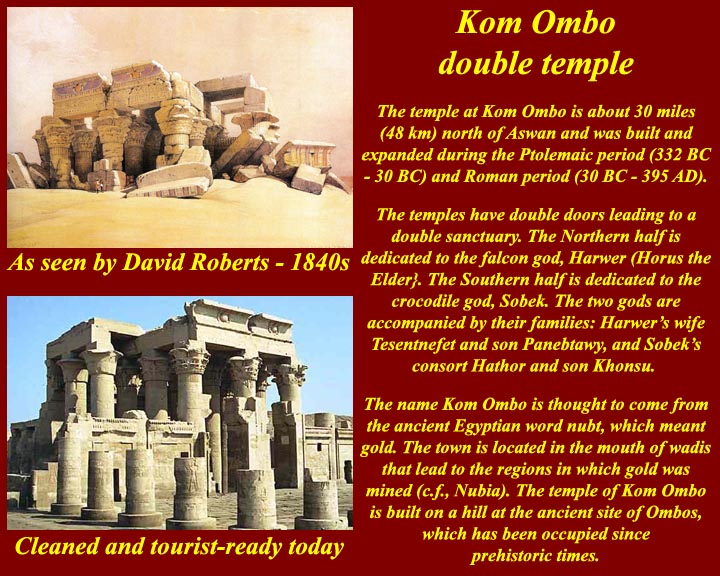
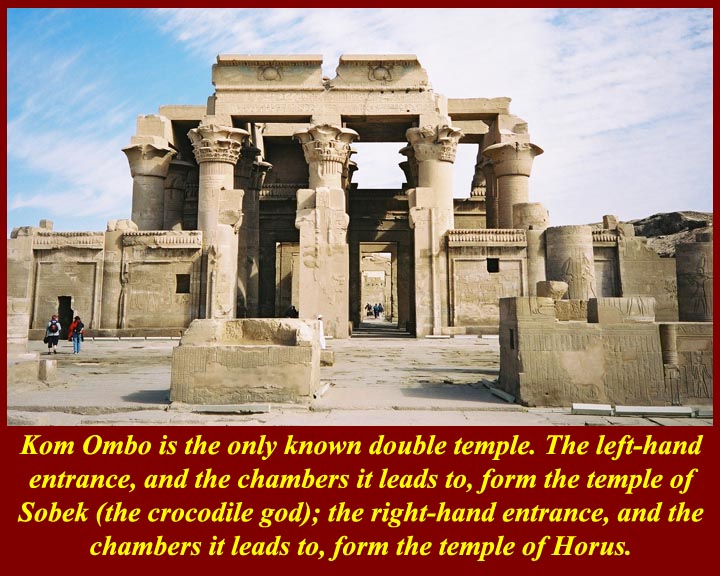
http://www.mmdtkw.org/EGtkw0849KomOmboTemplePlan.jpg
http://www.mmdtkw.org/EGtkw0850KomOmboDoubleTemple.jpg
http://www.mmdtkw.org/EGtkw0851KomOmboHorus-and-Sobek.jpg
The unique double temple at Kom Ombo was dedicated to Haroeris and Sobek. Haroeris is a Ptolemaic Greek name derived from the Egyptian Har Wer, one of the oldest forms of Horus, which, in turn was derived from a combination of the falcon-god, Har (Greek Horus) with an indigenous deity, Wer, "the Great One," a god of light whose eyes were the sun and the moon. Through increasing emphasis was placed upon the right eye, the sun, Haroeris was worshipped as Mekhenti-irty, "He on whose brow are the Two Eyes" or, on moonless nights as Mekhenti-en-irty, "He on whose brow there are no eyes," in which aspect he was the patron of the blind. Mekhenti-irty or Hor-merti was represented holding in his hands the wedjat or uraeus eyes of Horus.
So Haroeris/Har Wer was "Horus the Greater", and that title is sometimes misconstrued as the Elder, an error initiated by the Romans, who, in their own Latin, used maior and minor to mean elder and younge as well as greater and lesser. Haroeris, is sometimes recognized as the son or consort of Hathor; also he was the brother of Osiris and Seth. Various myths or legends surround the fight, or battle, involving Horus and Seth in which Horus lost one eye. One version is that Horus seemed to have recovered with two eyes, one he gave to Osiris as a token of life (and here there was conflation of the Wedjat eye and the Osirian ankh, the loop of which was eye-shaped), and the other for himself (the Wedjat eye). Horus then ascended the throne justified by the assembly of gods. This myth allowed Horus of Two Eyes to give way to Hor Nubti, "Horus (the Nubian) Vanquisher of Seth," or Horus of Ombos (the cult center of Seth), in other forms of the myth Horus is identified with Re or as the offspring of Isis and Osiris, in which case it would be Osiris who fought with Seth. Since Horus is also is both the son of Osiris and the new vessel of the Osirian Ba (life force) the confusion and conflation of the legends was acceptable.
The question remains, how did Har Wer get paired with Sobek, the crocodile god, who lived all up and down the Nile, not just in the Fayoum? Actually, the double temple is the result of the worship of two separate triads of deities -- not merged into a sextet. One set consists of Sobek, Hathor and their child Khonsu, while the other consists of Haroeris (Har Wer equated by the Ptolemaic Greeks with Apollo, or Horus the Greater/Elder), Tasenetnofret (the Perfect Companion) and their child Panebtawy (the Lord of the Two Lands). The last two have artificial names that express the goddess's function in such a group as a "consort," and the young god's to have the double kingship of Upper and Lower Egypt: in other words, the consort and pharaonic son of Har Wer. Of course, the two most important gods were Sobek, whose part of the temple is on the south and Horus the Greater/Elder, whose part of the temple is on the north, to which the temple was dedicated equally. This was why the temple was called both "House of the Crocodile" and "Castle of the Falcon". For more, see http://www.touregypt.net/featurestories/komombo2.htm.
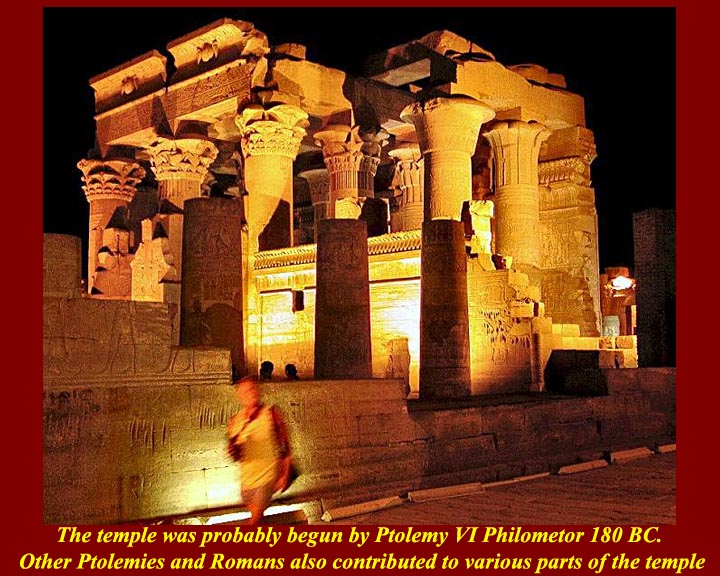
http://www.mmdtkw.org/EGtkw0852kom-ombo-temple-6903.jpg
Tourists' boats often arrive at Kom Ombo at evening twilight, so visits to the temple after dark are not uncommon.
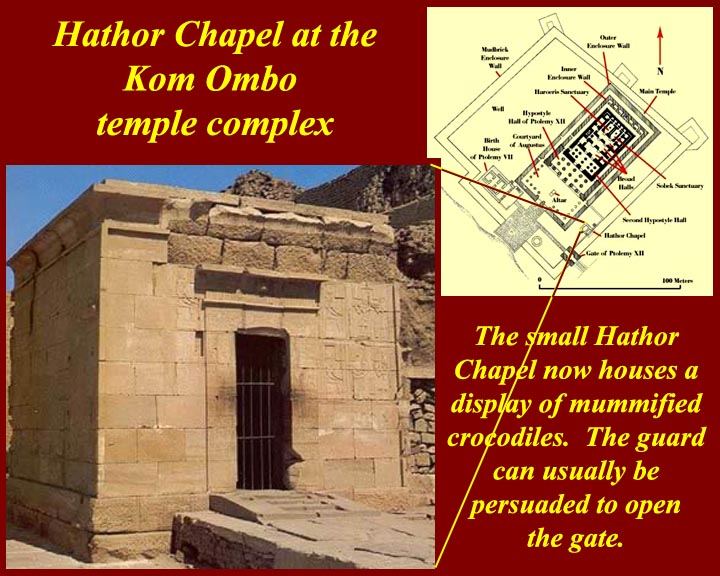
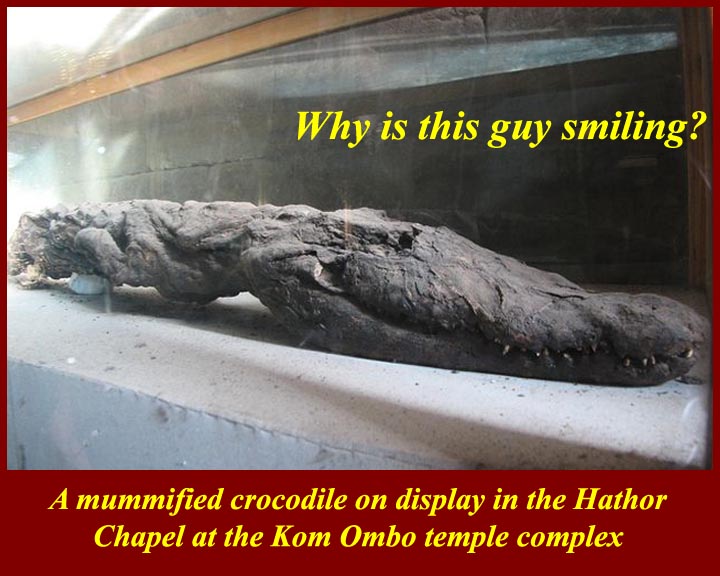
http://www.mmdtkw.org/EGtkw0853HathorChapelKomOmbo.jpg
http://www.mmdtkw.org/EGtkw0854KomOmboCroc.jpg
Although Kom Ombo was "Egyptian" at least as early as the late Old Kingdom (and already inhabited in pre-dynastic times) everything in the temple complex, which is pretty much all that has been excavated, is Ptolemaic. We don't know how far back the twin triads go. The Ptolemies were explicit about who they thought was the Perfect Companion of Har Wer: they built a chapel for Hathor and a Mamisi where she and Har Wer could have a little privacy. The chapel, however, has now been taken over by a bunch of mummified crocodiles that are shown to tourists.
The Crocodile's Toothache, by Shel Silverstein (1932 - 1999)
The Crocodile went to the dentist,
And sat down in the chair,
And the dentist said, "Now tell me, sir,
Why does it hurt and where?"
And the Crocodile said, "I'll tell you the truth,
I have a terrible ache in my tooth,"
And he opened his jaws so wide, so wide,
That the dentist, he climbed right inside,
And the dentist laughed, "Oh isn't this fun?"
As he pulled the teeth out, one by one.
And the Crocodile cried, "You're hurting me so!
Please put down your pliers and let me go."
But the dentist just laughed with a Ho Ho Ho,
And he said, "I still have twelve to go--
Oops, that's the wrong one, I confess,
But what's one crocodile's tooth, more or less?"
Then suddenly, the jaws went SNAP,
And the dentist was gone, right off the map,
And where he went one could only guess...
To North or South or East or West...
He left no forwarding address.
But what's one dentist, more or less?
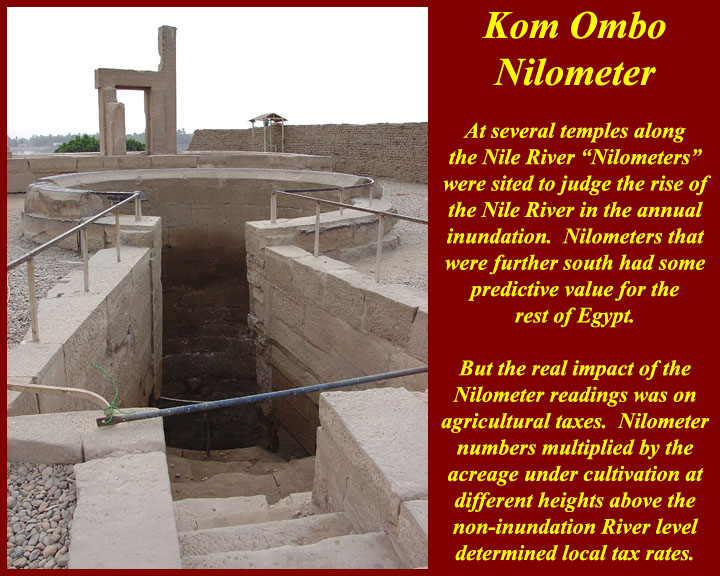
http://www.mmdtkw.org/EGtkw0855KomOmboNilometer.jpg
Nilometers were invented by Pharaonic Egyptians but named by the Ptolemies. The name says it all, it measured the Nile's level. This was important because farm taxes were based on the level of the inundation multiplied by the area of owned land.
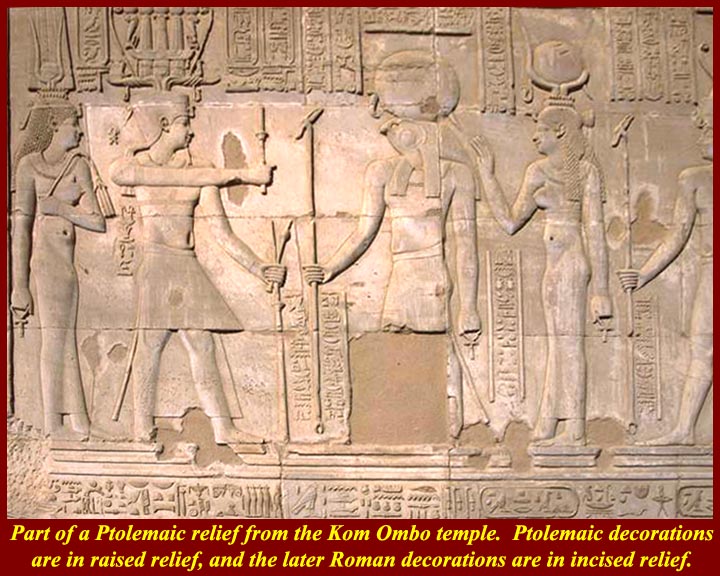
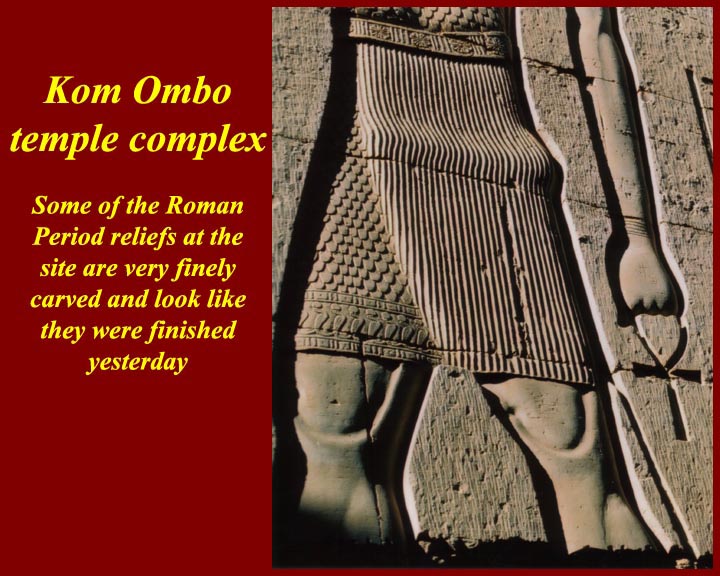

http://www.mmdtkw.org/EGtkw0856PtolemaicReliefKomOmbo.jpg
http://www.mmdtkw.org/EGtkw0857KomOmboRomanRelief.jpg
http://www.mmdtkw.org/EGtkw0858KomOmboPillarRelief.jpg
At Kom Ombo, but not necessarily at other sites, Ptolemaic and Roman reliefs are easily distinguished. The Ptolemies paid for Raised relief while the Romans used the cheaper incised relief form. Incised reliefs last longer than raised reliefs, because they are below the stone surfaces. They are also harder to erase and replace with later reliefs.
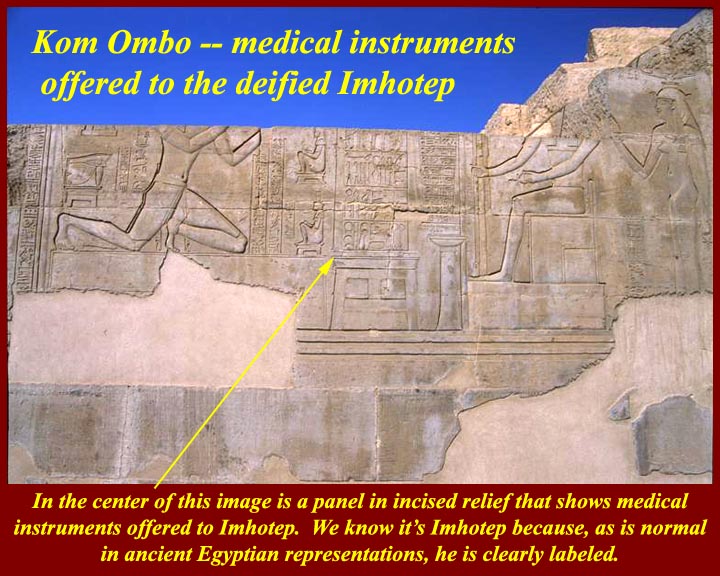
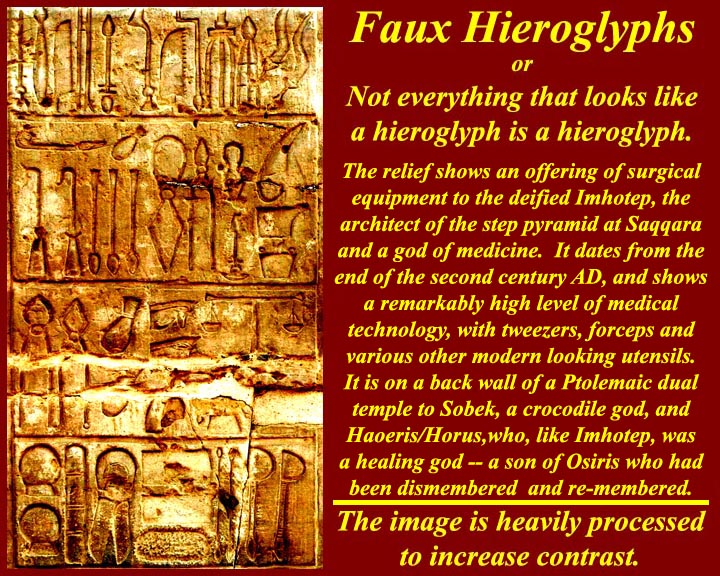
http://www.mmdtkw.org/EGtkw0859KomOmboMed.jpg
http://www.mmdtkw.org/EGtkw0860KomOmboMedRelief.jpg
A partial relief of medical instruments being offered to the deified Imhotep survives on a wall of the Kom Ombo temple. Although he is perhaps best remembered as the architect of the Djoser Step Pyramid, the first pyramid in Egypt, he also wrote medical texts which were used not only in Egypt but throughout the region and for many centuries after Egypt had declined. For more on Imhotep, see http://www.touregypt.net/featurestories/imhotep.htm.
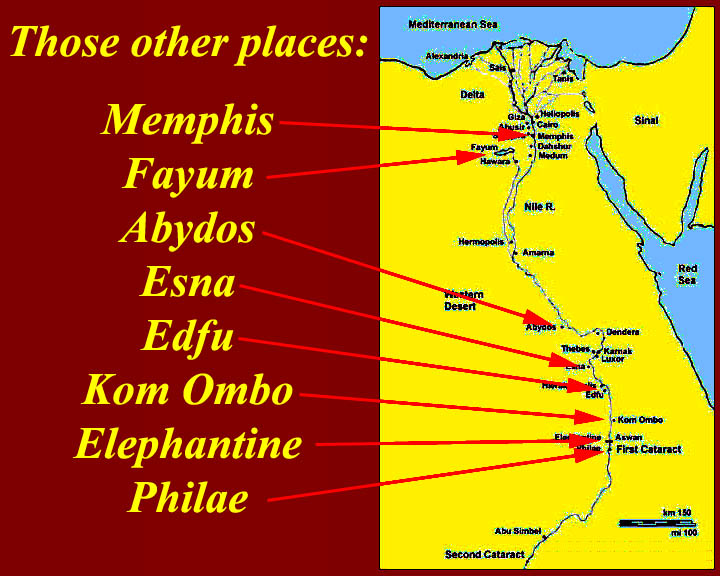
http://www.mmdtkw.org/EGtkw0861EgyptMap.jpg
That first map again to remind us of where we're talking about.
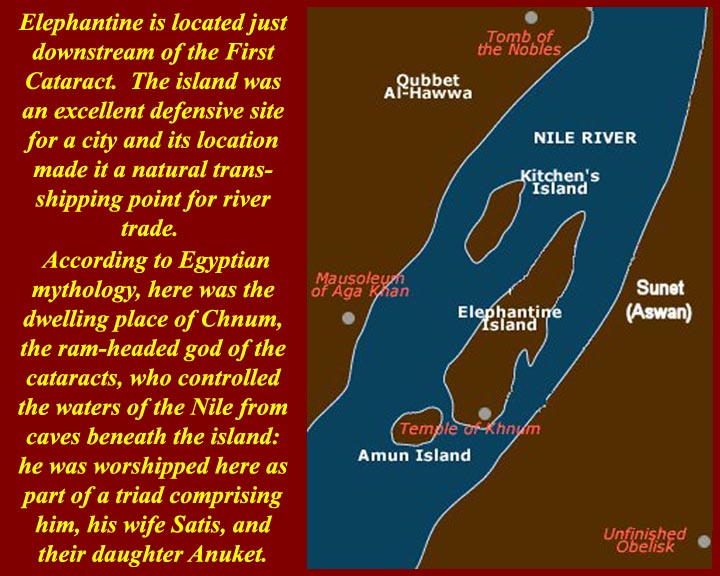
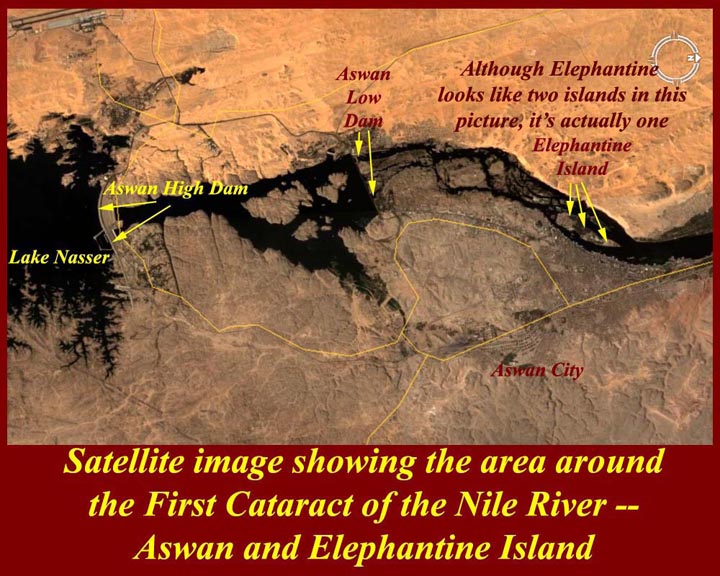
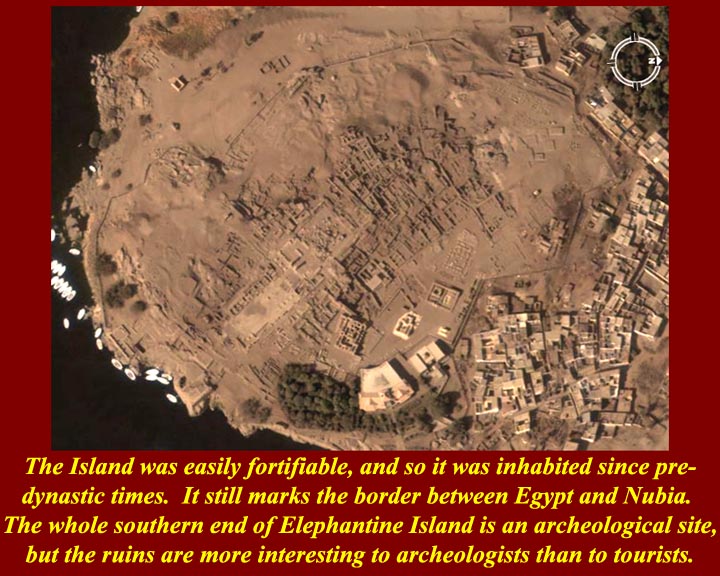
http://www.mmdtkw.org/EGtkw0862ElephantineAswanMap.jpg
http://www.mmdtkw.org/EGtkw0863AswanElephantine.jpg
http://www.mmdtkw.org/EGtkw0864ElephantineSouth.jpg
Elephantine Island is at the First Cataract of the Nile River, just a bit north of the Old Aswan Dam. From early pre-dynastic times it has marked the unofficial border between Egypt and Nubia and has been a secure settlement area and trading entrepot. The chief god of the Island was ram-headed Khnum in his guise as controller of the waters of the Nile. He is part of a triad with Satis (a formerly Nubian Gazelle goddess) and their daughter Anukhet. But he's also linked to the frog goddess Heket, whose cult center was also on the island.
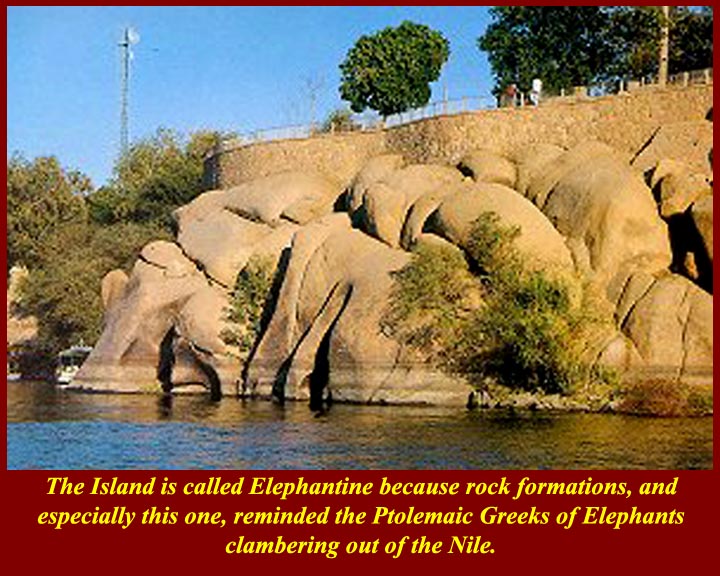
http://www.mmdtkw.org/EGtkw0865ElephantineRocks.jpg
The Ptolemaic Greeks named the island Elephantine because they thought these rocks looked like a herd of elephants lumbering out of the water. The earliest known recognizable elephant ancestors evolved in the Nubian Nile Valley about 65 million years ago, but the population had died out by 2000 BC. The Ptolemies, however were familiar with Indian elephants: King Ptolemy I (Soter) fought with Alexander the Great in India at the Battle of the Hydaspes, against two hundred Indian war elephants. The beasts nearly defeated the Greeks, but careful tactics saved the day for Alexander, in 326 BC. At various times the Ptolemies even owned some war elephants that they had captured in battle (Battle of Gaza, 312 BC). About 297 BC, Ptolemy I Soter forbade killing African elephants for their ivory in southern hunting expeditions -- he wanted to train them for war. (Remember that this is also the time when King Pyrrhus of Epirus, a cousin of Alexander and a ruler of another of Alexander's successor states, was arming himself with elephants that he later used in war against Greeks, Carthaginians, and Romans. Elephants were just coming on line as every nation's weapons of mass destruction.)
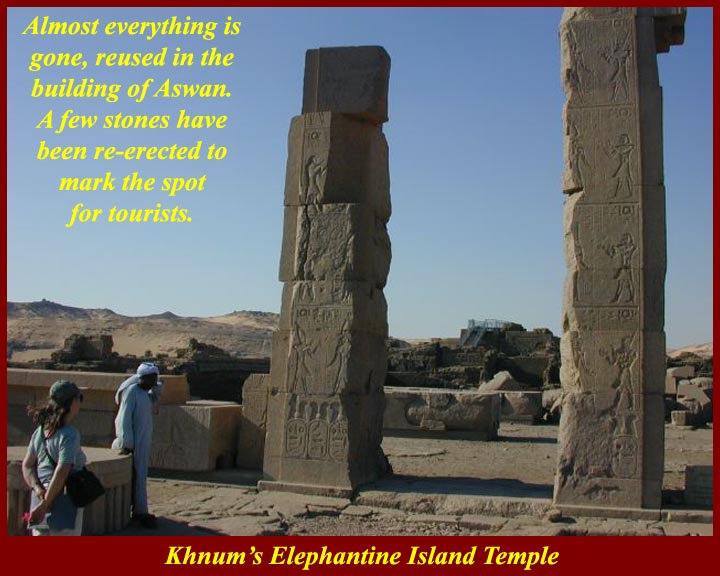
http://www.mmdtkw.org/EGtkw0866aKhnumTempleElephantine.jpg
The Khnum temple (if fact all the temples) on Elephantine Island is almost totally and literally dilapidated. Lapidus is a Latin word for a stone, and in particular for a worked stone. Dilapidated means that the stones were taken out or away.
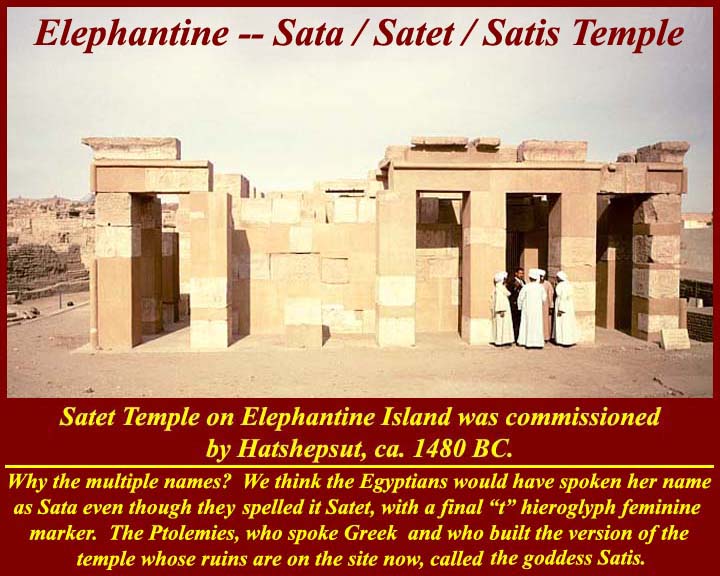
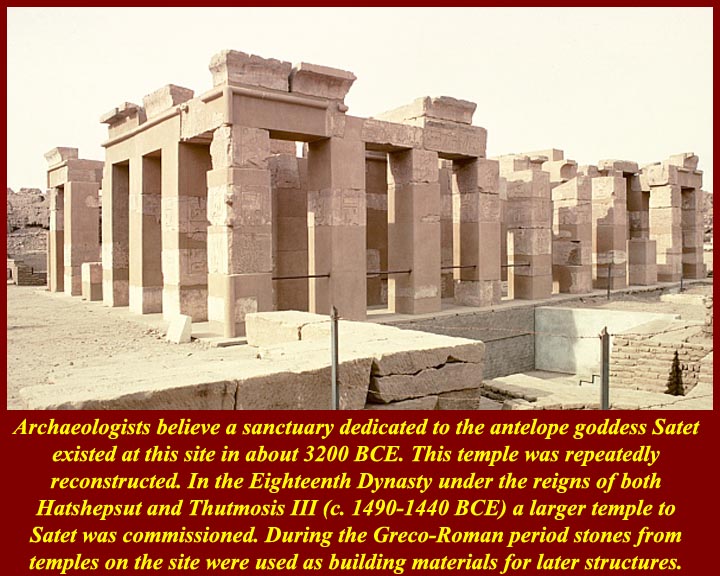
http://www.mmdtkw.org/EGtkw0866ElephantineSatetTemple.jpg
http://www.mmdtkw.org/EGtkw0867ElephantineSatet2.jpg
There is more to see at the Satis temple site, but it also is a recent reconstruction of the temple's Ptolemaic iteration using more new stone than old. This might be appropriate since even in ancient times the temple was reconstructed repeatedly.
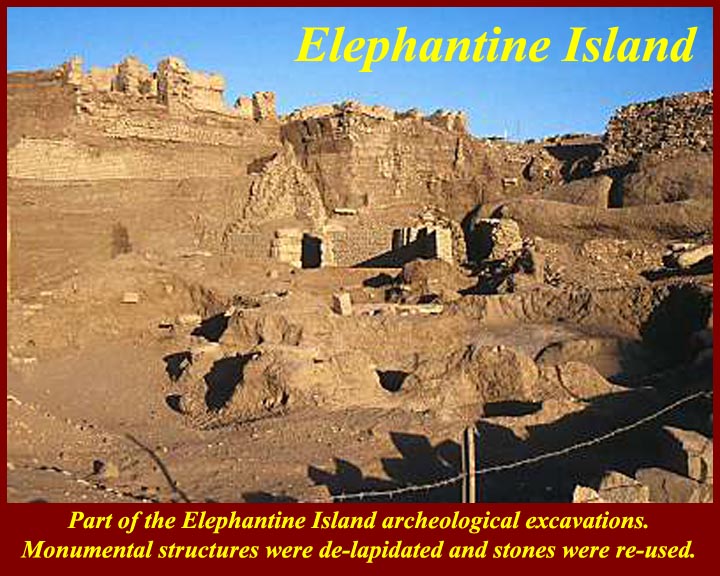
http://www.mmdtkw.org/EGtkw0868ElephantineArcheology.jpg
Elephantine Island archeology is, therefore, a matter of finding foundations and then finding stones to match and making replacement stones for those not yet (or never to be) found.
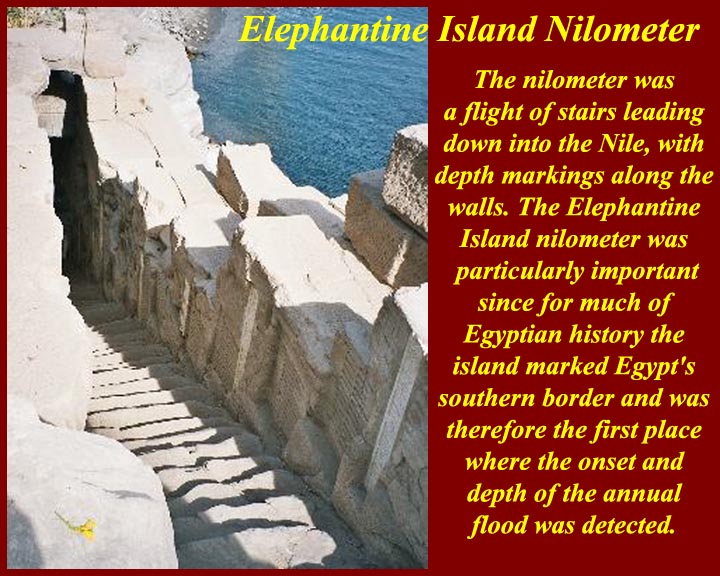
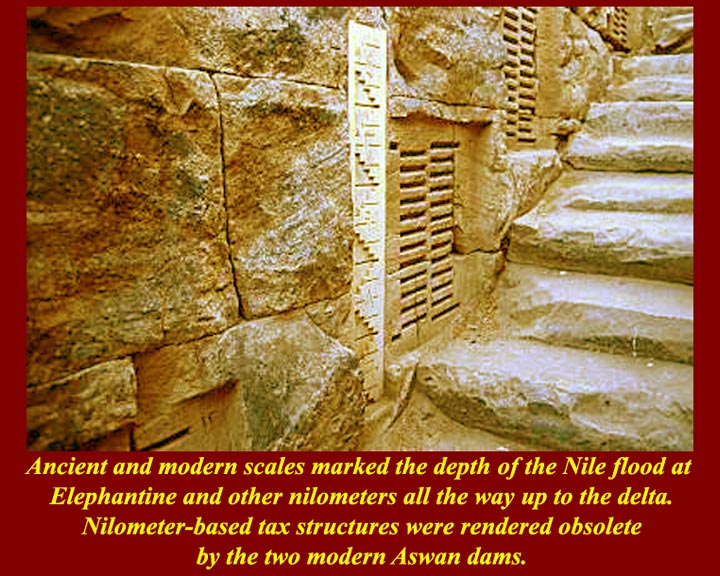
http://www.mmdtkw.org/EGtkw0869ElephantineNilometer.jpg
http://www.mmdtkw.org/EGtkw0870ElephantineNilometer.jpg
The Elephantine Island Nilometer was one of the most important: at the border with Nubia, it was the place where Egyptian officials got the first indication of the expected depth of the annual inundation.
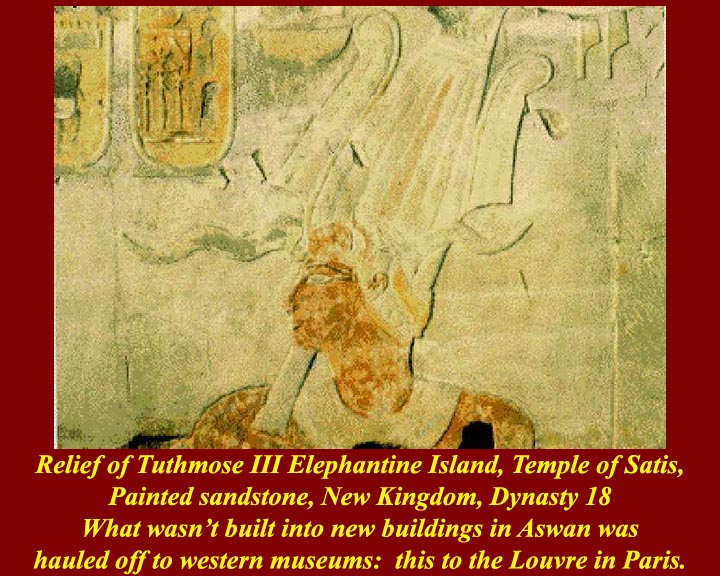
http://www.mmdtkw.org/EGtkw0871ElephantineThutmoseIII.jpg
A painted sandstone relief of Thutmose III was taken from Elephantine and is now in the Louvre.
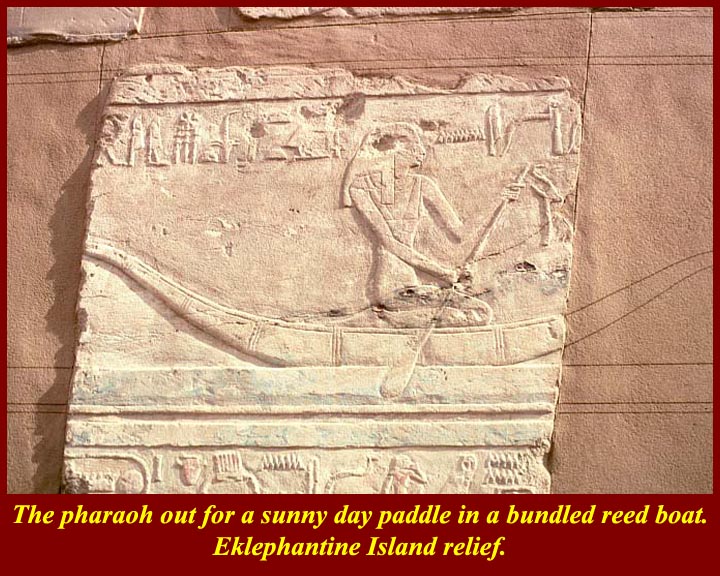
http://www.mmdtkw.org/EGtkw0872BundledReedCanoe.jpg
A partial relief that is still on the Island shows a pharaoh in a bundled reed canoe.
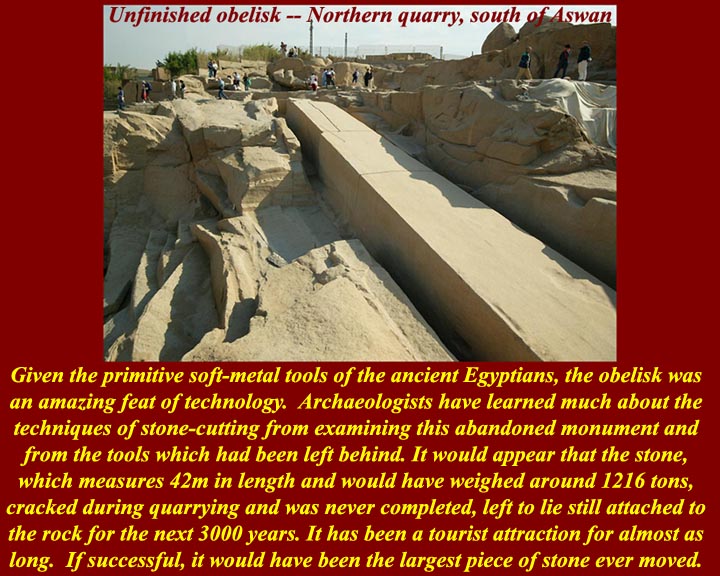
http://www.mmdtkw.org/EGtkw0873UnfinishedObelisk.jpg
On the eastern side of the Nile, opposite the southern temple area on Elephantine are the red granite quarries that made Aswan the source of monumental stone. This failed obelisk would have been the most monumental of all if it hadn't cracked due to a hidden flaw in the stone. At 42 meters and an estimated 1216 tons, it would have been the biggest and heaviest stone ever moved. The tallest existing obelisk is the one in the plaza behind the Lateran cathedral in Rome at 32 meters -- it was 36 meters before it was cut when it was removed from the Circus Maximus. When this obelisk cracked, efforts were made to salvage parts of it by sawing out sections, but the flaw ran deep and long: the sawn sections also developed cracks. If the obelisk had been a success, it still would have to be slid to a landing area when the river was at its height and then transported by ship to it's downriver destination, presumably the Luxor or Karnak temple complex. This one was a failure, but that 36 meter obelisk that Augustine brought to Rome would have made the same journey, then later to Alexandria, and finally to Rome, all in wooden ships that weren't surpassed until the 19th century.
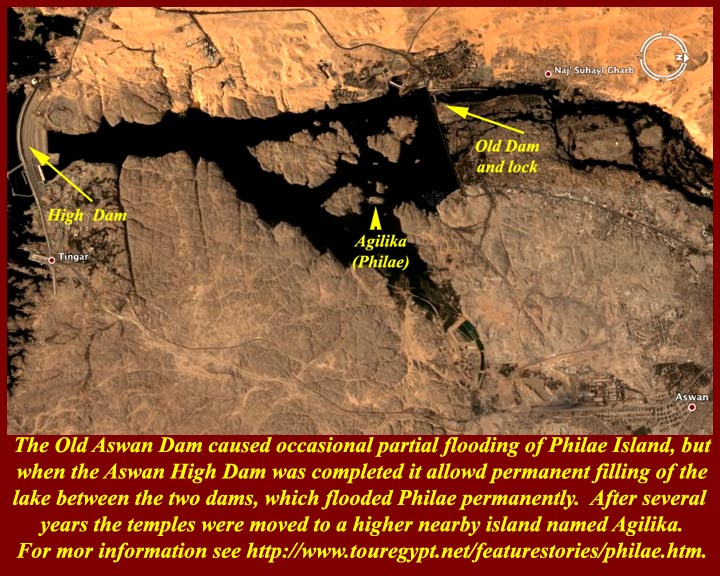
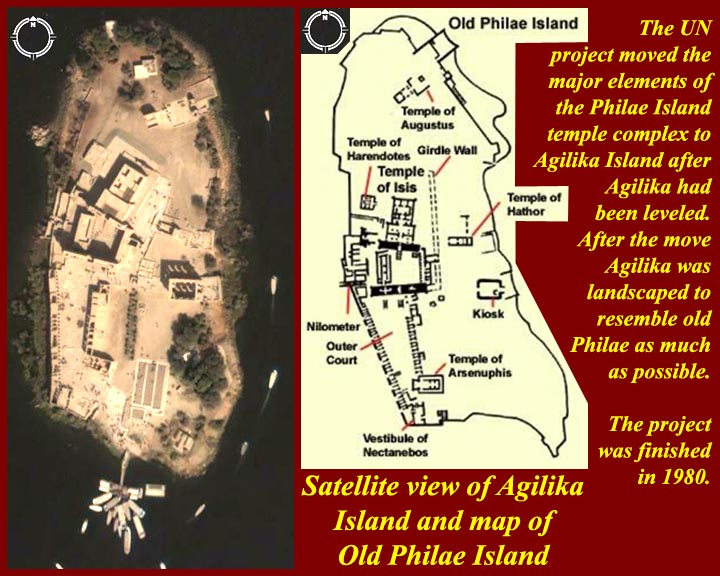
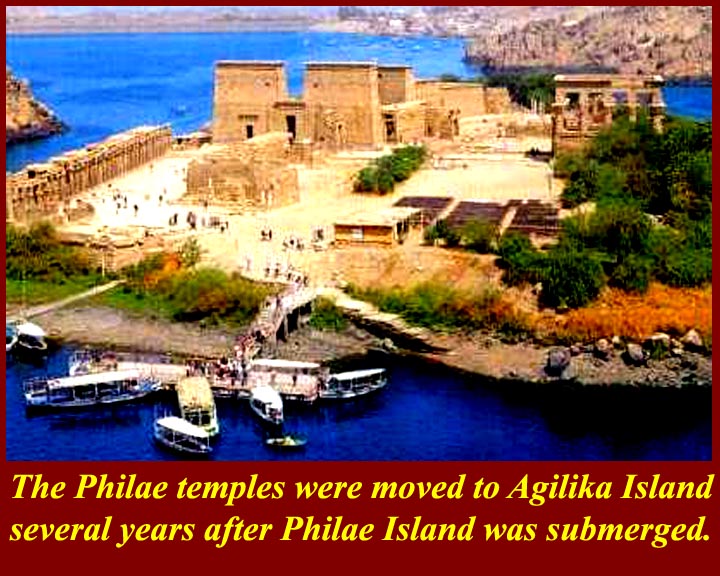
http://www.mmdtkw.org/EGtkw0874AswanAreaSatellite.jpg
http://www.mmdtkw.org/EGtkw0875AgilikaPhilae.jpg
http://www.mmdtkw.org/EGtkw0876PhilaeAgilika.jpg
Agilika Island, like the now submerged Philae Island is in the middle of the small lake between the Old Aswan Dam and the Aswan High Dam. Be for the High dam was built, Philae and its temple complex was periodically flooded, but after the completion of the High Dam it was flooded permanently, and, worse, the water level fluctuated around the temples leading to rapid deterioration. Eventually a cofferdam was built around the Philae complex, all the water was pumped out, and the whole temple complex was moved to Agilika, which is high enough to keep the temples out of water. The whole project was completed by 1980, and since then the complex has become a fixture of the Egyptian tourism routes.
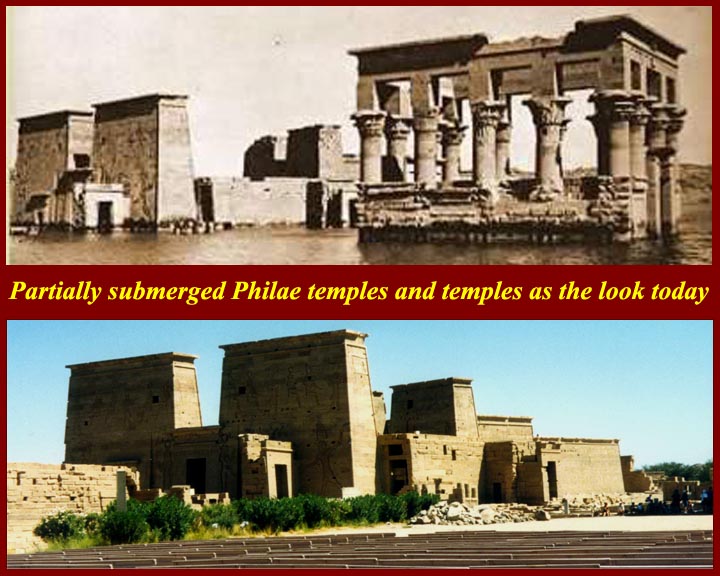
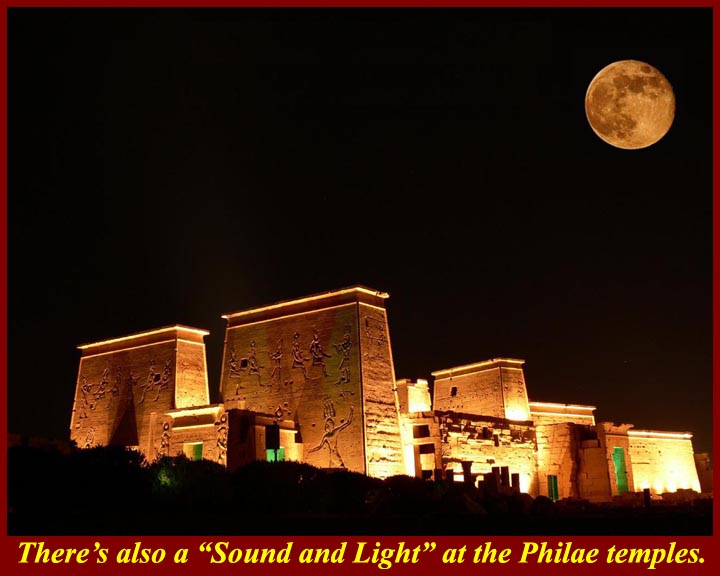
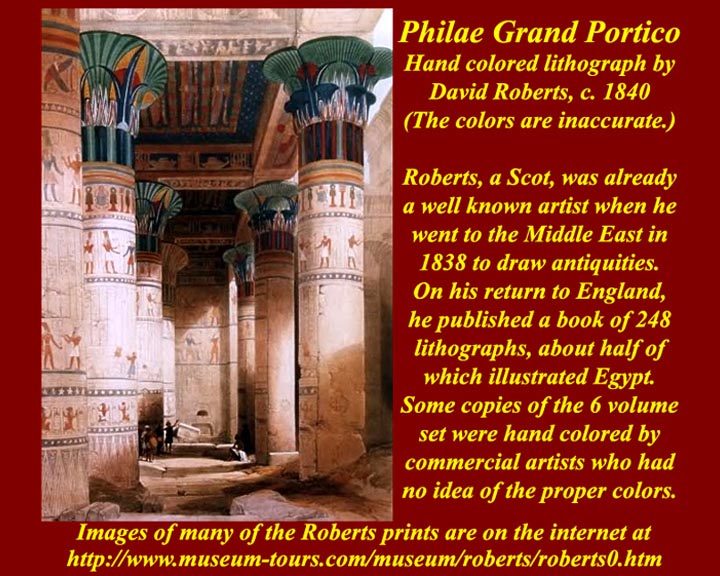
http://www.mmdtkw.org/EGtkw0877PhilaeSubmerged.jpg
http://www.mmdtkw.org/EGtkw0878PhilaeNight.jpg
http://www.mmdtkw.org/EGtkw0879RobertsPhilae.jpg
Views of the Philae temple complex. The main temple belongs to Isis / Aset / Aysay. but there is also a smaller Roman temple that the Arabs call the Pharaoh's Bed and the archeologists call Trajan's Kiosk.
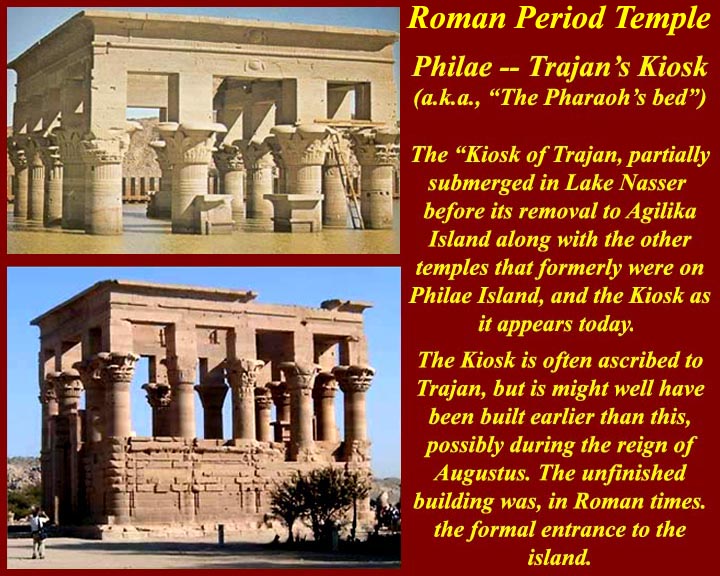
http://www.mmdtkw.org/EGtkw0879RomanPhilae.jpg
Trajan's Kiosk flooded on Philae Island and at its new location on Agilika.
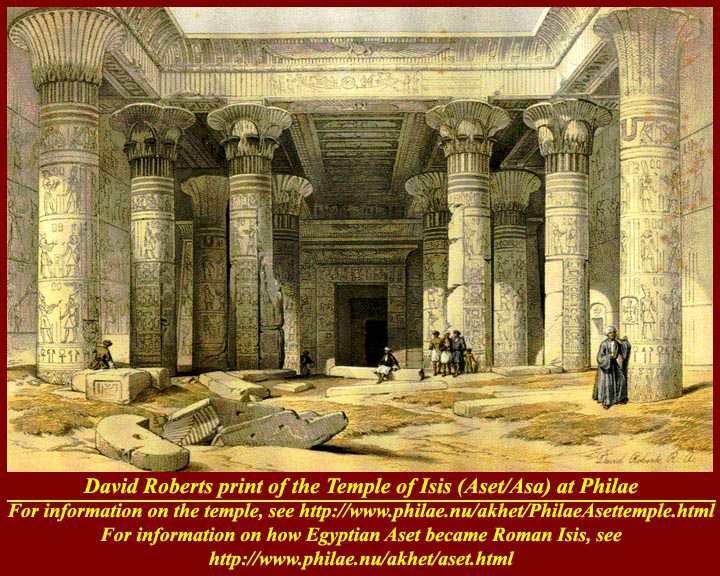
http://www.mmdtkw.org/EGtkw0880AsetIsisTemplePhilae.jpg
The David Roberts drawing of the Isis temple on Agilika, copied from a print from one of the Roberts travel books.
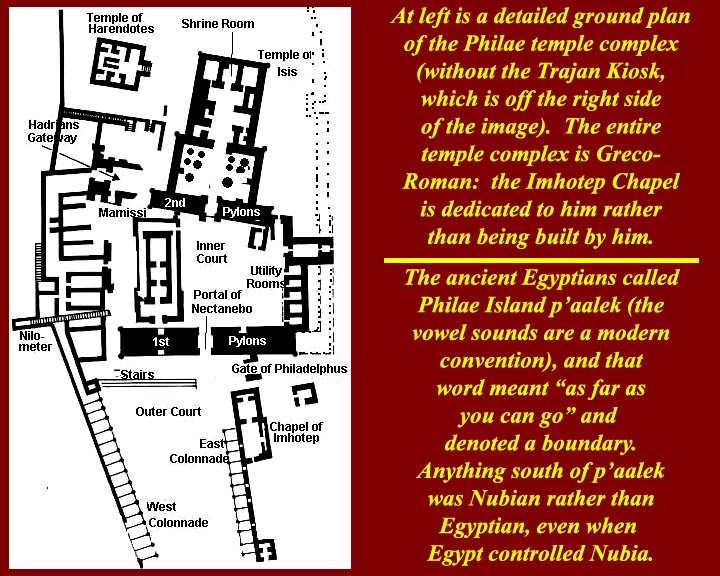
http://www.mmdtkw.org/EGtkw0881PhilaeTempleMap.jpg
Philae Temple complex on Agilika: ground plan (without Trajan's Kiosk). Philae is the Macedonian Greek and Roman name for the Island. The ancient Egyptians called it something like P'aalek (vowel sounds merely conventional) which meant: the edge, the end, or the border.
